Long Bets
This is the text version of a talk I gave in September 2024, at the Sales Success Summit conference in Austin, TX. If you prefer the audio version you can find a podcast of the talk here.
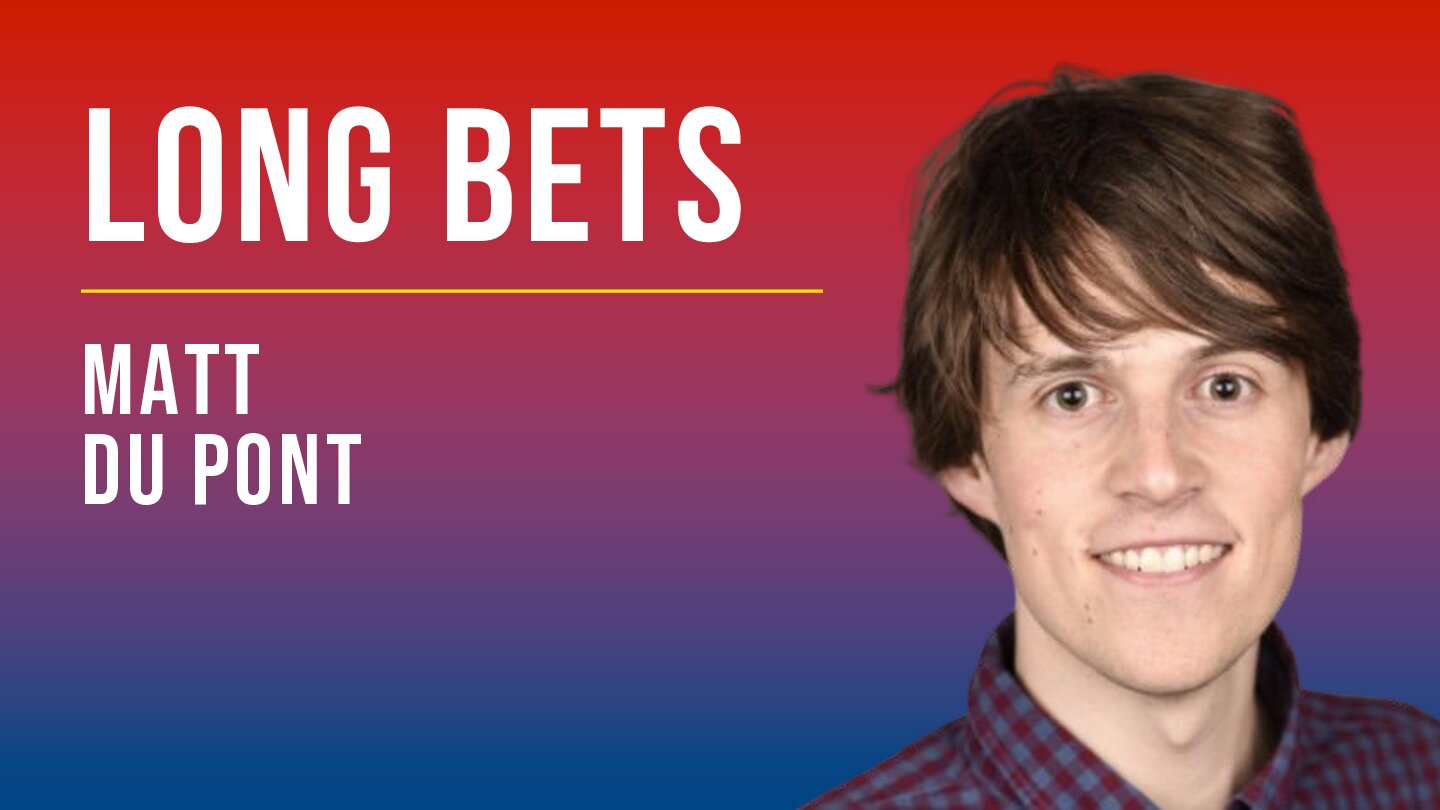
Hey everyone, I'm Matt. Four years ago at this conference, I gave a talk about how I've tracked every working minute of every day I've spent in sales so I can optimize my commission per hour, which made you all correctly think I was crazy. I'm still doing that.
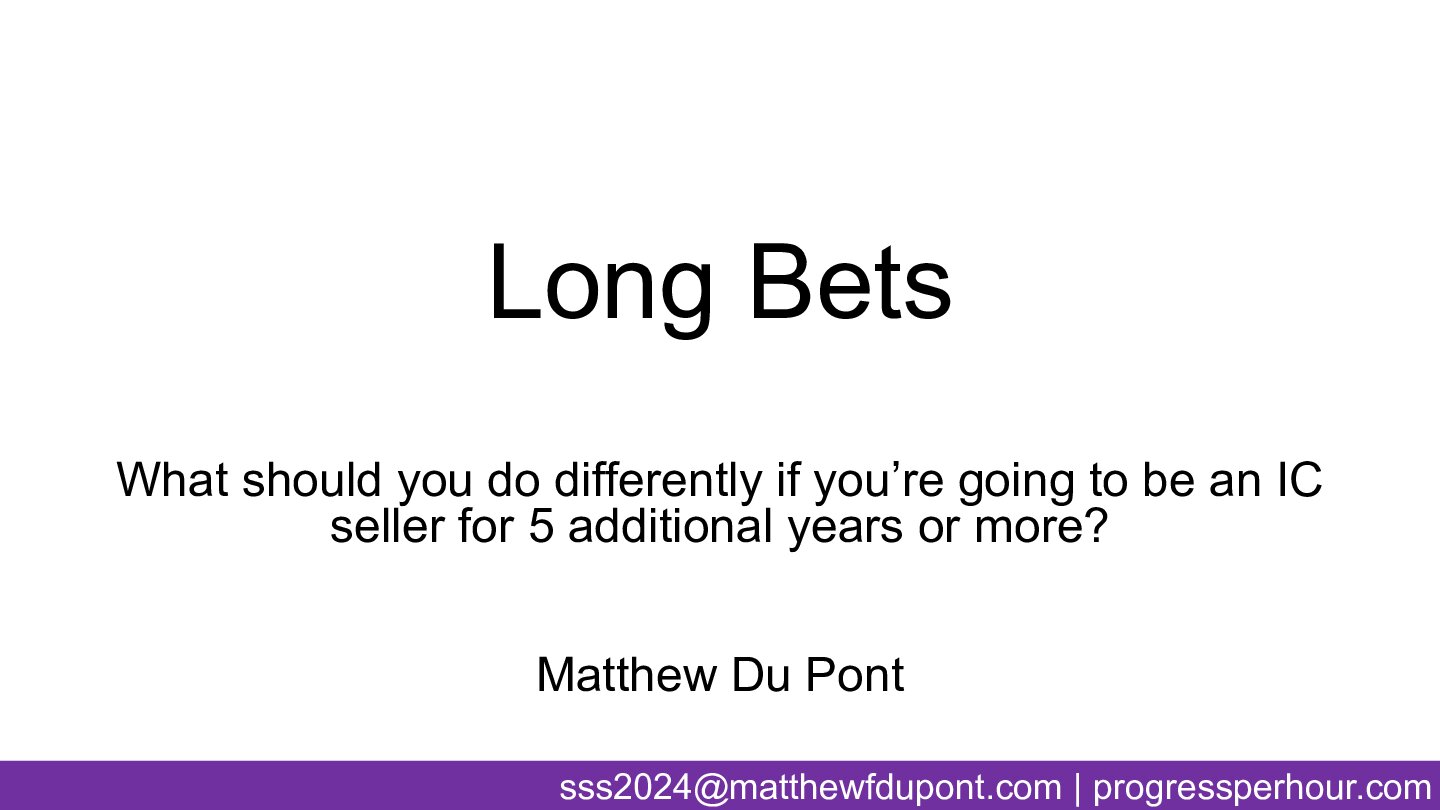
I'm not going try and convince you that's a good idea. Today I'm here to talk about long bets.
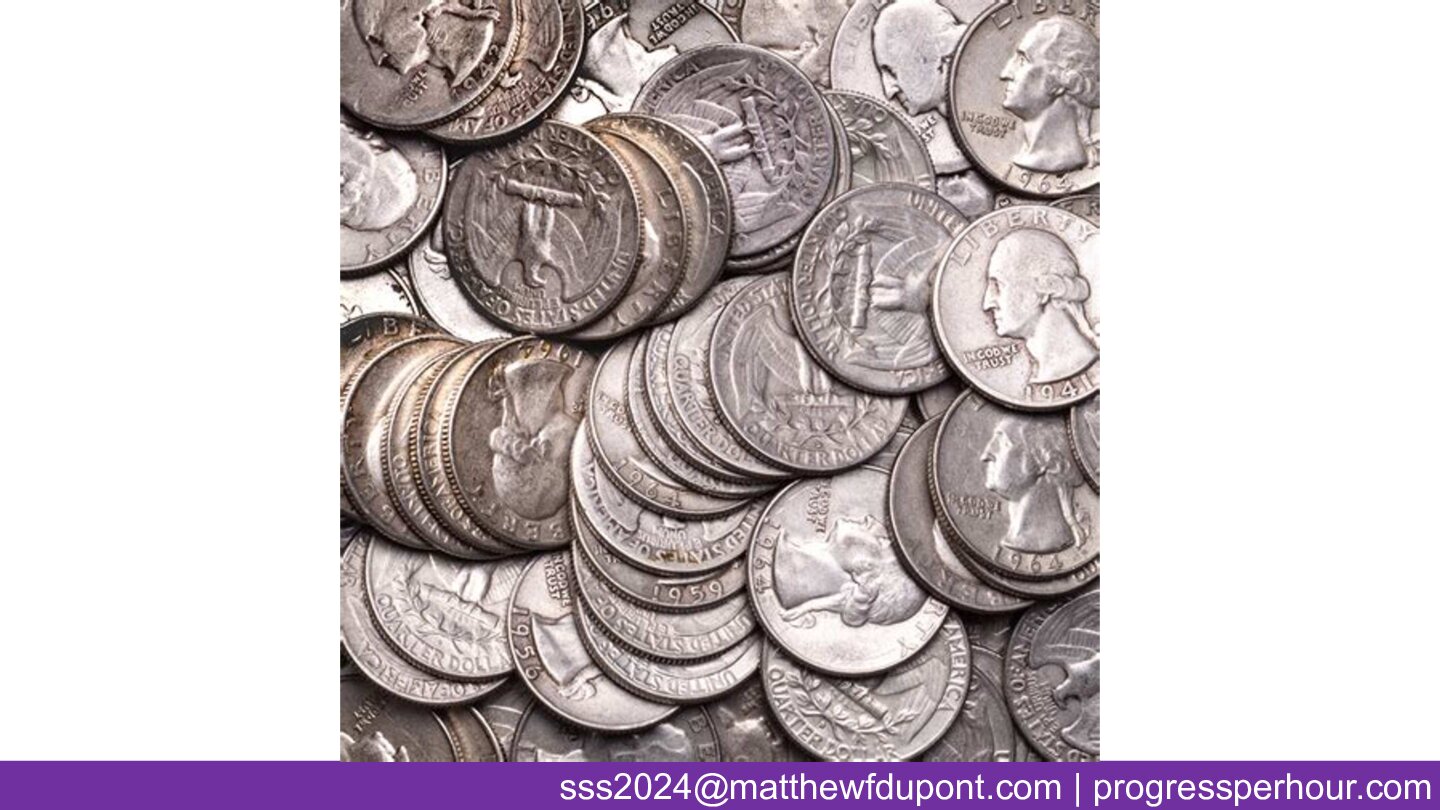
What I mean by long bets is that as salespeople, we're called upon to think about our life in terms of quarters, or maybe years if you're in an annual role. Your leadership and your comp plan want you focused on the short and the medium term.

And what I'm here to talk about is a different set of "long bet" strategies, which are similar to planting a tree. You need to put in a little work up front. You have this tremendous output at the end, but it takes a while to pay off. So this means that if you're planning to move into sales leadership or if you're retiring soon, congratulations, but these strategies that I'm going to talk about are not really going to pay off for you.
However, the majority of people in this room and people who watch this video later have self-selected into being individual contributors for the long haul. And I'm about five years into running some of these strategies, they're starting to pay off and I hope they'll be valuable to you as well. Some caveats: I'm not the most successful salesperson, I'm not going to claim this is the universal right answer, and I'm not someone like Brandon where I've tested this on a bunch of other people. Your mileage may vary.

But I think it's very safe to make two claims. First, that most salespeople are not deliberately making long-term bets, which I'll define as deliberate moves that pay off a year or more from the time they make that move. And secondly, if you choose to do that consistently, you can accumulate some tremendous advantages compared to people that aren't thinking on that sort of time scale.
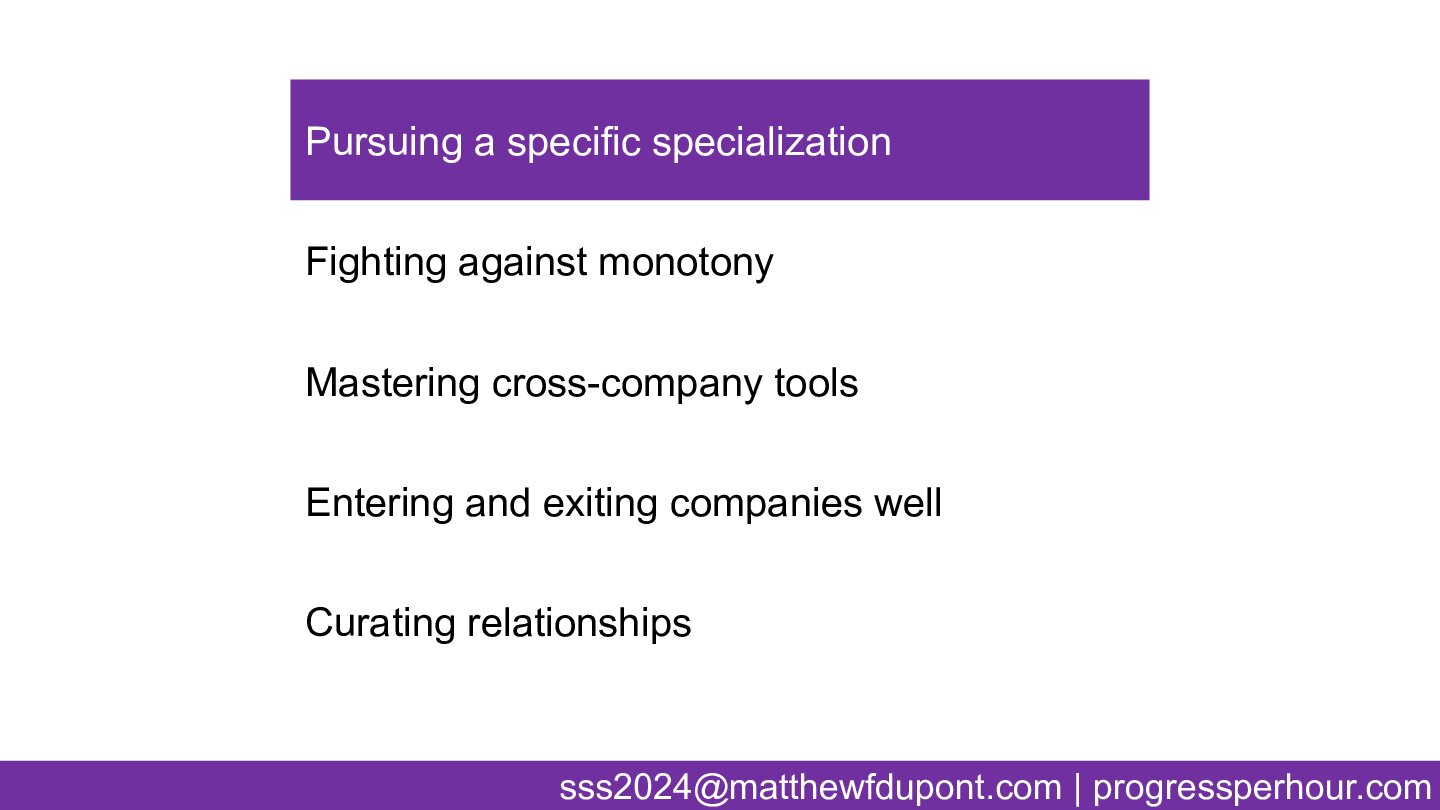
So let's jump into the actual content. We're to start off by pursuing a specific specialization. And a common theme that we're going to talk about today is repetition.
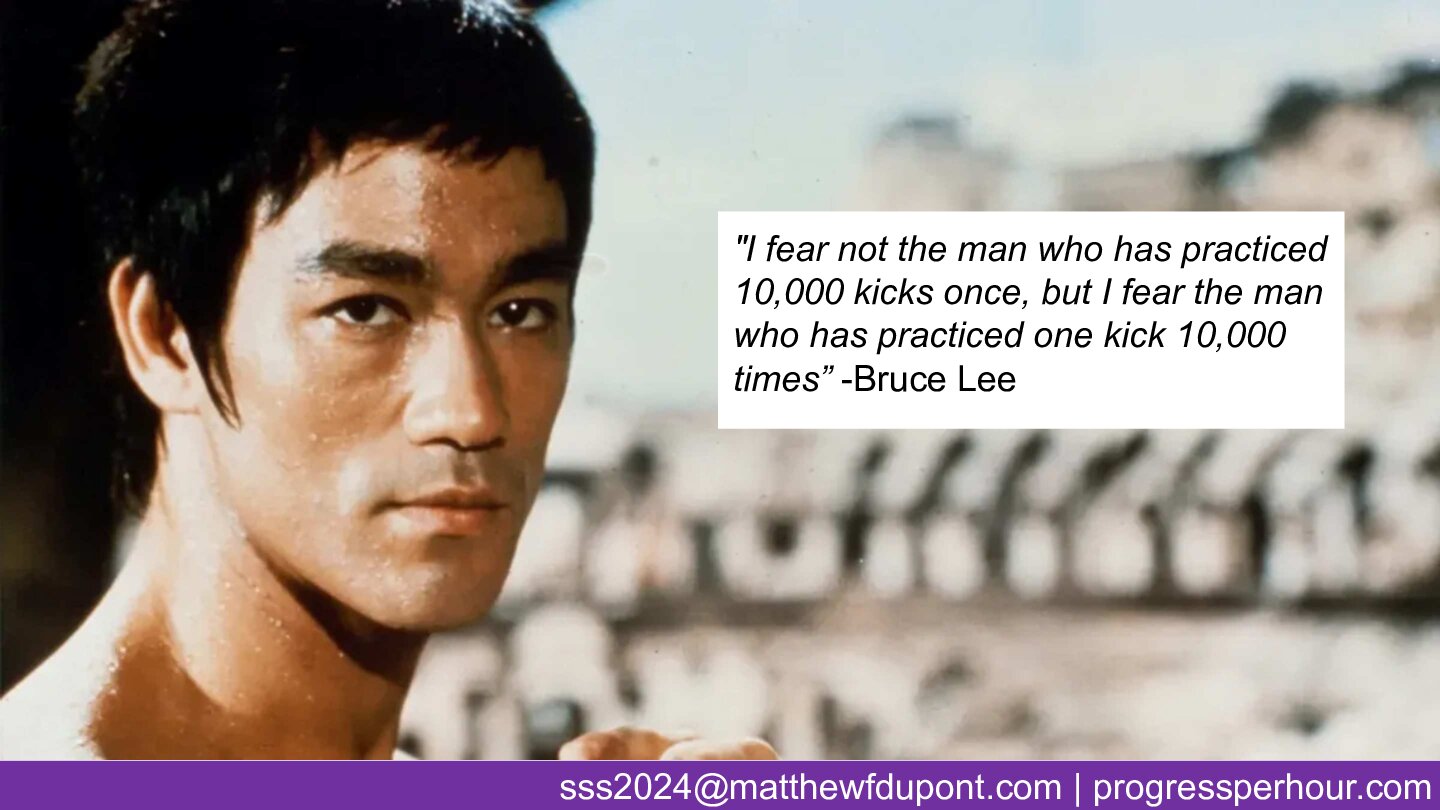
Repetition: doing something over and over and over, more than someone else does, to attain a higher level of skill than is common. And I think one of the most important areas of to focus on is figuring out the exact kind of sales you really want to do and sticking to that across a five or ten or fifteen year period. So I'm going to walk a little bit through my own personal journey, since if you haven't thought about some of this stuff it took me a while to think about, maybe you can avoid my mistakes and figure out your goals a few years earlier than I did.
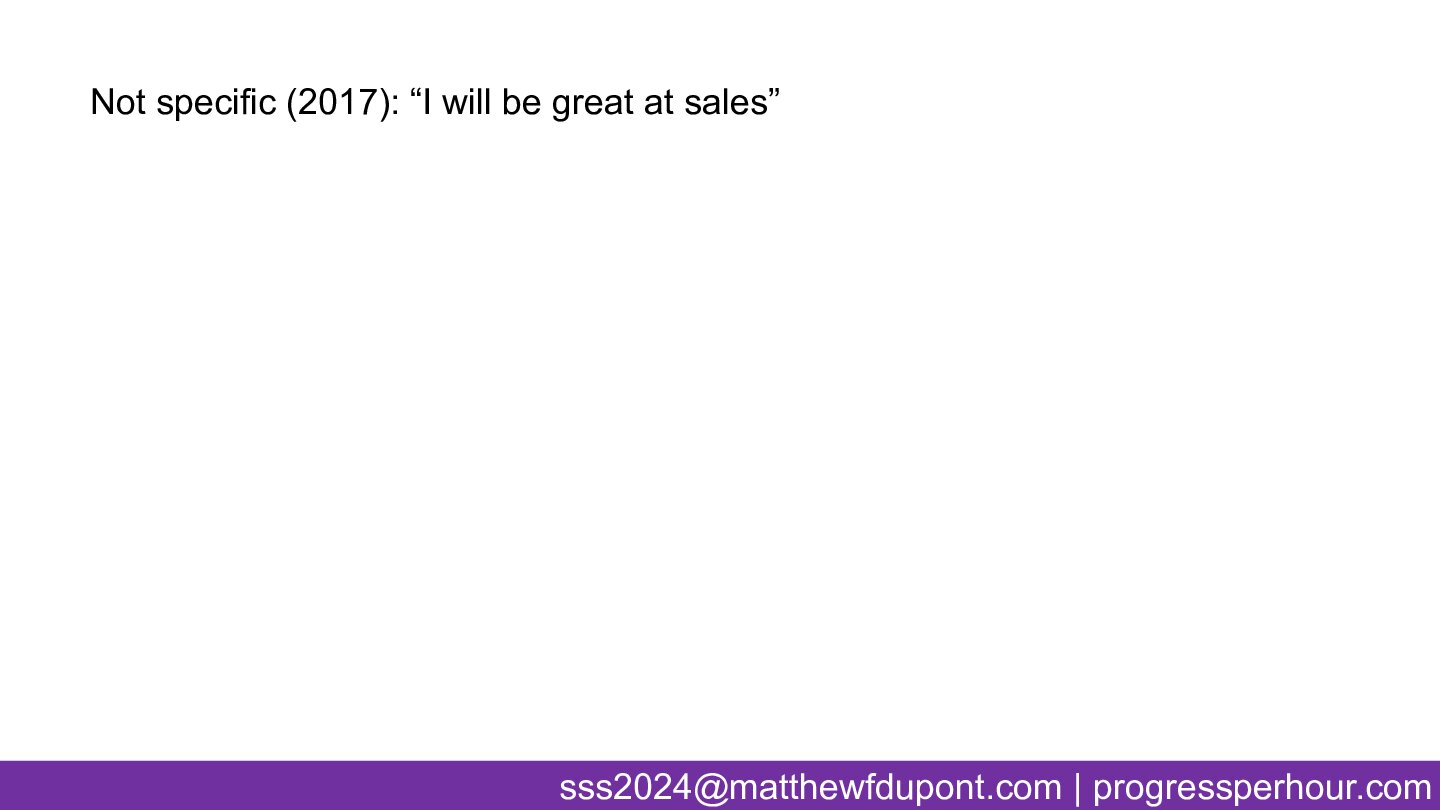
So I started off in sales after doing six years of product management and software engineering. At that time, I just knew I liked this whole sales thing a lot better than what I was doing before and I want to get good at it. That's not really useful framework for picking jobs or how to prove yourself, but it's a start.
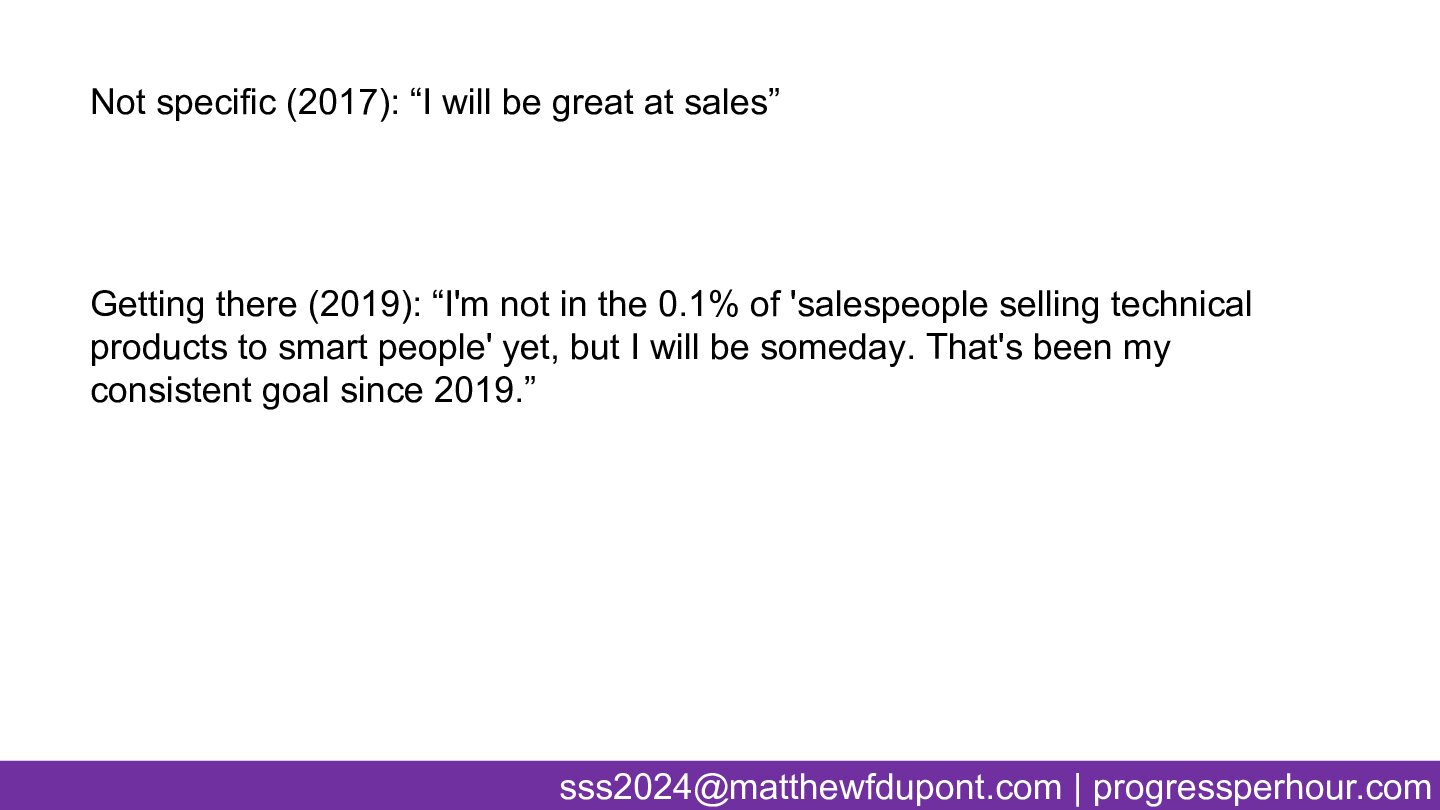
Over time, I developed more review on what kind of buyer I wanted to be selling to. So I learned I really like talking to the kind of engineers I intellectually respect, and I don't have fun selling to HR.
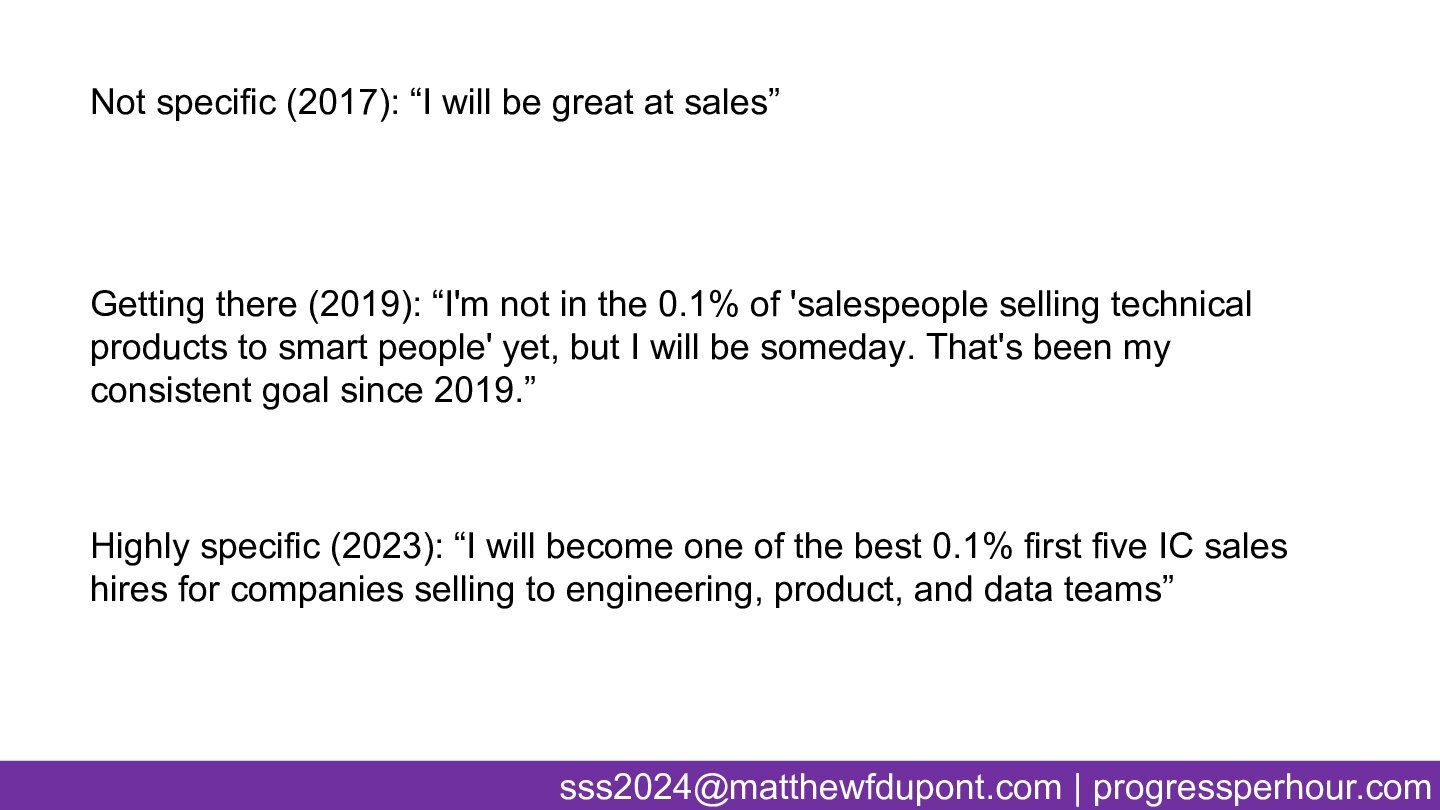
And now a few years later, I've gotten more in touch with myself and realized there's a type of company I want to work for as well. What I'm going to do is dig into some of the questions I asked myself along that journey. If you haven't taken a deliberate and principled stance on these things, I'd recommend you do, even though I'm sure your answers will be very different than mine.
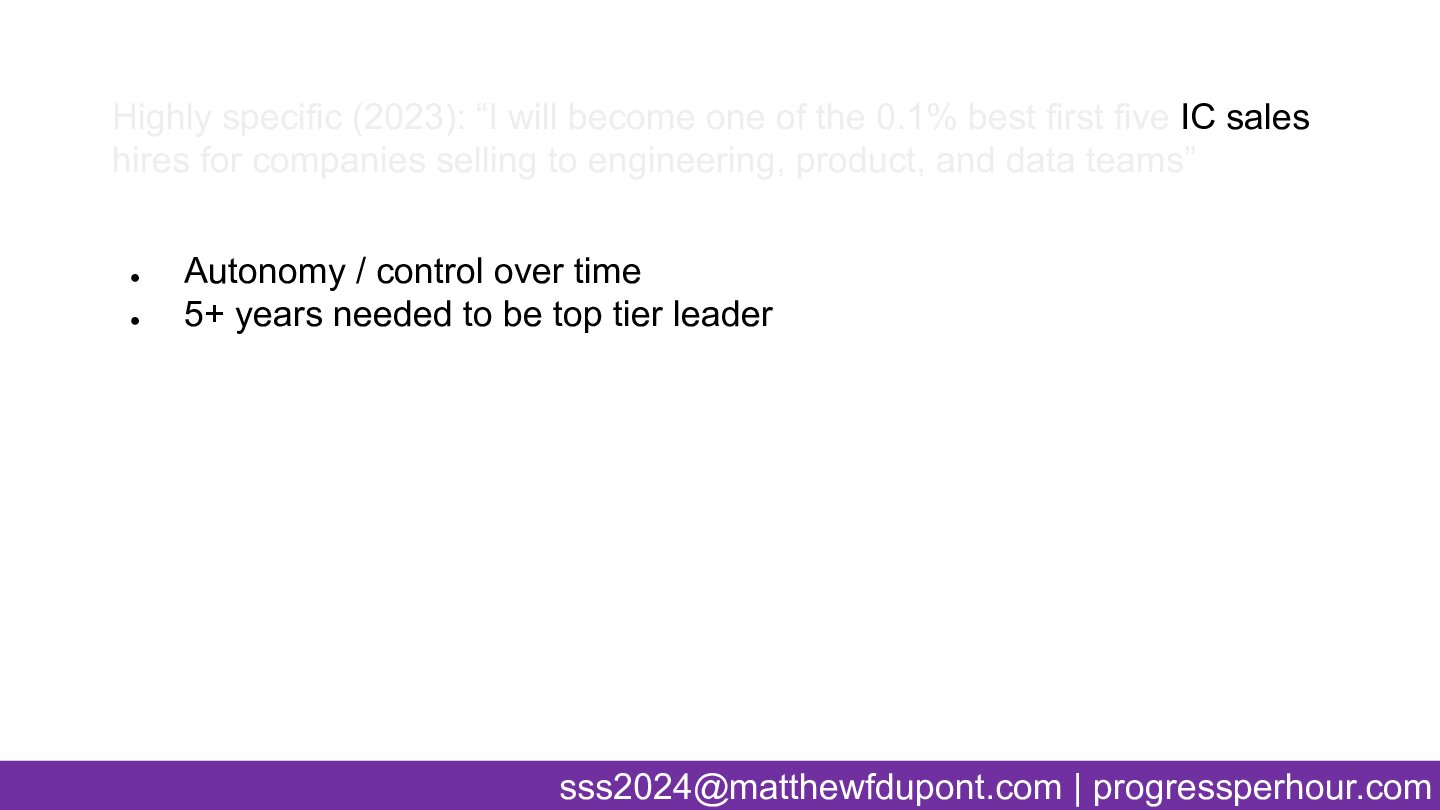
So first of all, I aim at being an individual contributor long-term, instead of a people manager. This is not a hard sell to this room. I want autonomy and freedom. I've seen what a VP's calendar looks like, and the choice is quite clear.
But also, if you happen to be good at something already, it takes a while to become elite at something else, right? Moving to leadership is making a bet on something you don't necessarily know you like, and you're burning a couple of years for an uncertain outcome.
And so if you think you're going to love leadership, great, go for it. But if you don't have a reason to validate that desire, perhaps just stick with what you're doing.
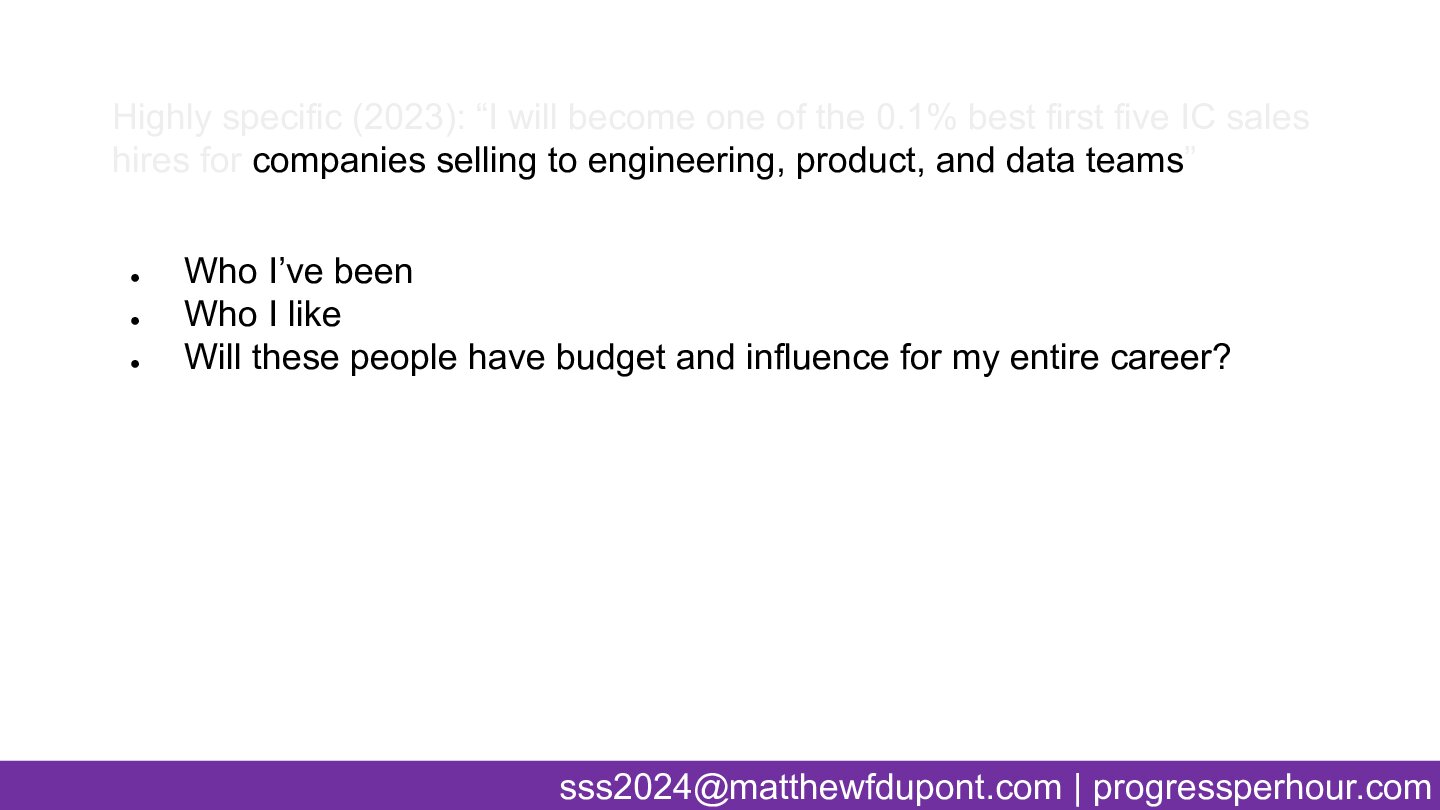
Additionally, I have a specific buyer that I'm seeking to work with in a very focused way. And there are three questions I asked myself to get to that buyer.
First, who have I been in the past? So I was an engineer, I was a PM. People in those roles are generally skeptical of salespeople. And so it helps a lot when you're selling to them that you have been in that seat. But even if you just went right into sales, there's probably something you learned in school or someone you've been selling to for a while. And I'd argue that unless you have a really good reason to go away from it, play to your path dependent advantages where you have a systematic and unfair advantage against other people that would be up against the same comp plan as you.
Secondly, who do you actually like? Do you want to be friends with these people for the next couple of decades? Do you want to wake up and talk to these people over and over? If your answer is no, get to a buyer you love as soon as that's possible in your career. And if your answer is yes, don't switch to a company that pays a little more money or seems a bit more exciting at the cost of losing your buyer network.
And then finally, are these people still going to be important for the rest of my career? You might meet the other two criteria selling to human translators, but in the age of AI, I have bad news about your future market size. So are you betting on these folks to have buying power in 10 years or 15 years if that's the time scale you're playing on? I think engineers will be more powerful when I retire than when I started, so I'm happy focusing there.
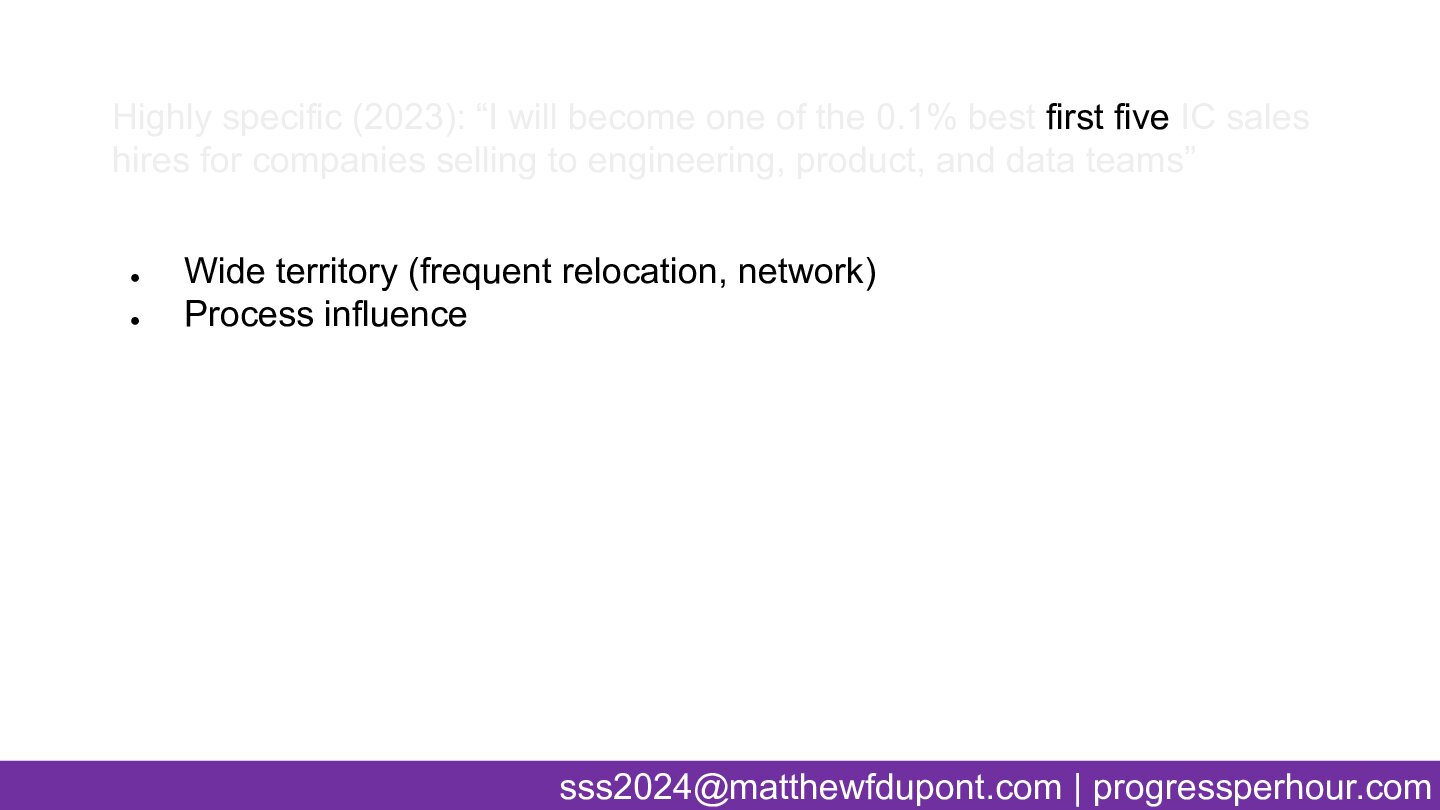
A less common thing you should think about deliberately across multiple jobs is company size. Now I'm a bit odd in this room, but I want to be one of the first few salespeople working somewhere instead of at a big company. Big companies have a lot of great stuff going for them: you have name recognition, you get to do all those sexy mega deals people talk about, you build an internal network of people you work with that will be useful to you in the future. But the bigger the company, the smaller the territory.
As context, I work for this great software company called GrowthBook selling AB testing software. I'm very happy there. I just want to thank them here because they're letting me show you a bunch of screenshots later in this presentation that any big company would fire me for showing you.
At GrowthBook, I sit in Philadelphia and get to talk companies all over the world. If I was working at a megacorp like Amazon, I talk to three companies.
Now, there's two issues with that. One is I'm going to move in the future. My wife's in academia.I follow her around with a laptop and an internet connection. And so if you're going to move in the future and you're being forced by your company to develop a regional network that you might not be using in the future, you might want to think about playing it differently.
But more importantly, I'm making multiple years long efforts in investing in a widely spread network. If I work at a big company, they're going to tell me I can only sell to 1% of that network since I'll have a list of 20 or 50 companies I can sell to. And so I'm making a long bet that by bringing that network to company after company after company, I'm not going to have to do nearly as much work in a few years because I aim to work with some of the same people over and over. There's very different things you need to do to build a wide network of engineers, versus, say become the queen of marketing tech for public companies in Cincinnati. But if you don't have a very focused long term strategy, I'd encourage you to develop one.
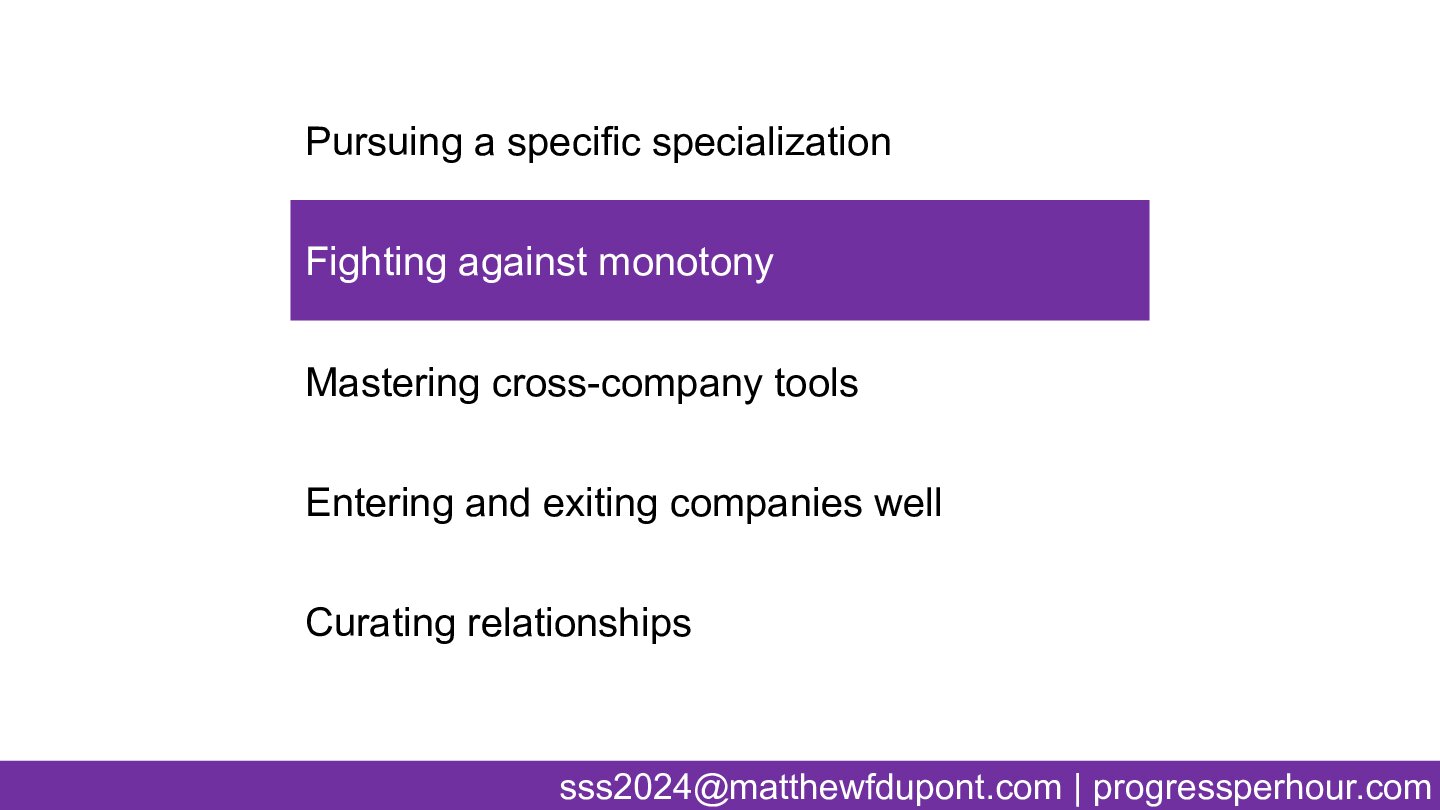
Whatever your answer is, this leads to our next big problem: specialization has huge benefits, but it's also kind of boring. And so you need to figure out how to fight against monotony.
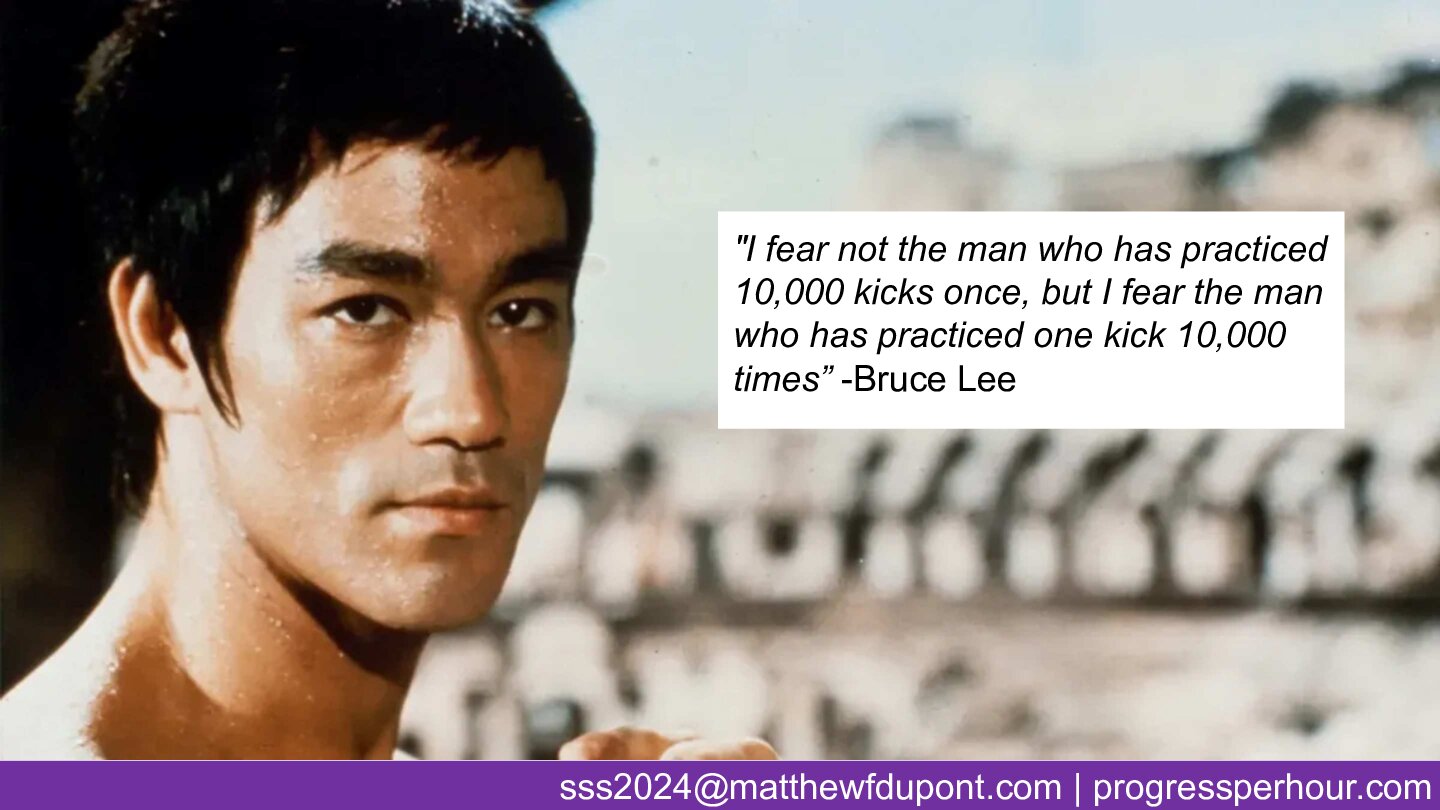
Because to go back to our Bruce Lee quote from earlier, it's powerful if you deliberately practice, but who's excited to train that same kick 10,000 times? If that excites you, more power to you, but most people, that's not intrinsically very fun.
And so there's this tension where a lot of us, myself included, got into sales because we want to have a lot of time to spend with our families. We want to make enough money to get out of this game and go on to whatever's next for us that has more intrinsic meaning. But when you get really good at a lucrative sales job and get in the best position to make that money and have free time, you're bored out of your mind, because you've solved the sale for the company you're at so well that you can work for four hours a day and print cash. Perhaps you get so bored with the lack of challenge, you move to a new job with new and exciting challenges. And so now your work is more fun, but you've traded that against the things you actually came into this career to get.
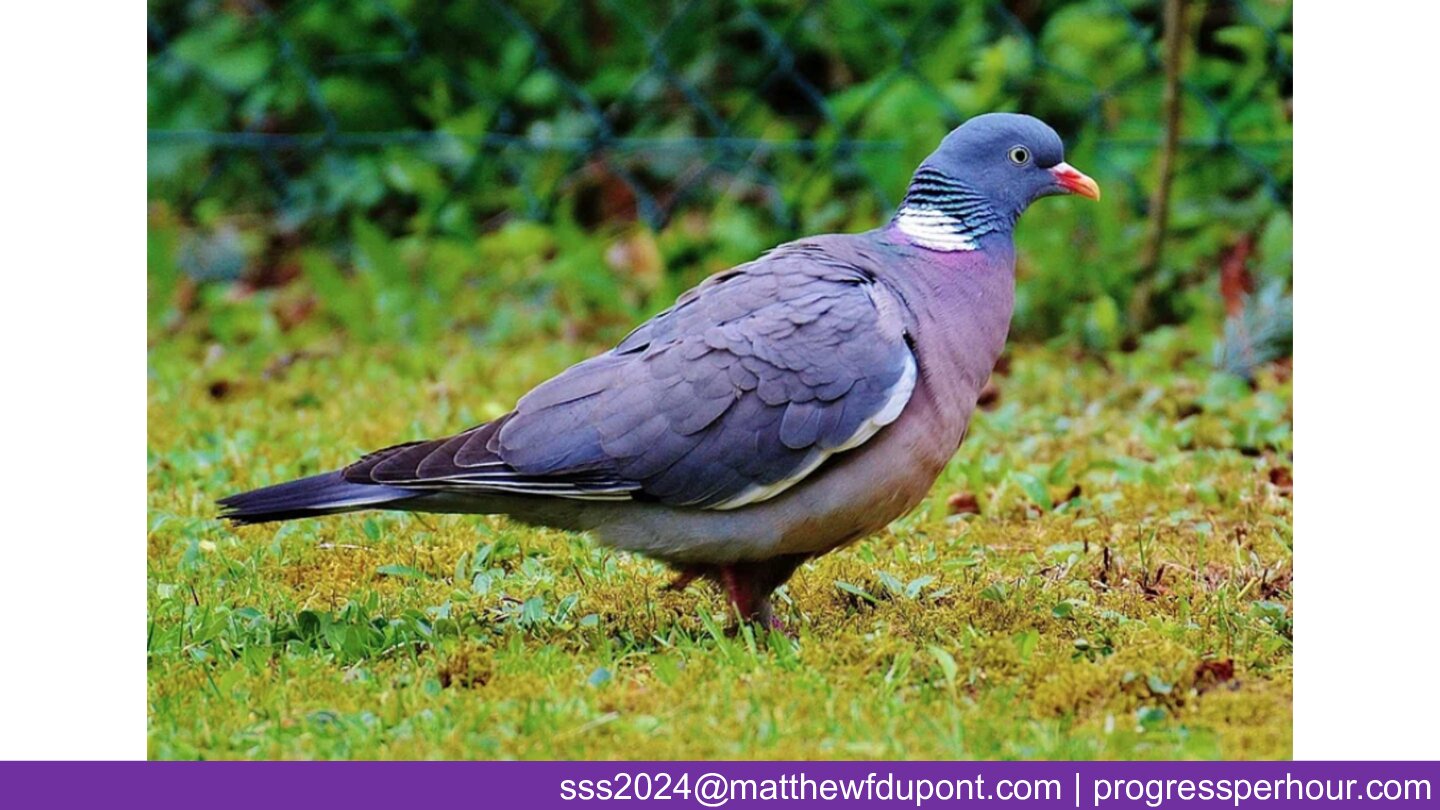
Not getting bored quickly is actually an important skill to develop if you're thinking about this as a long game. And I'm going to join a lot of our speakers in talking about daily routines now to help with that. But I'm very confident I'm the only person that's going to talk to you about being more like a pigeon in a lab experiment.
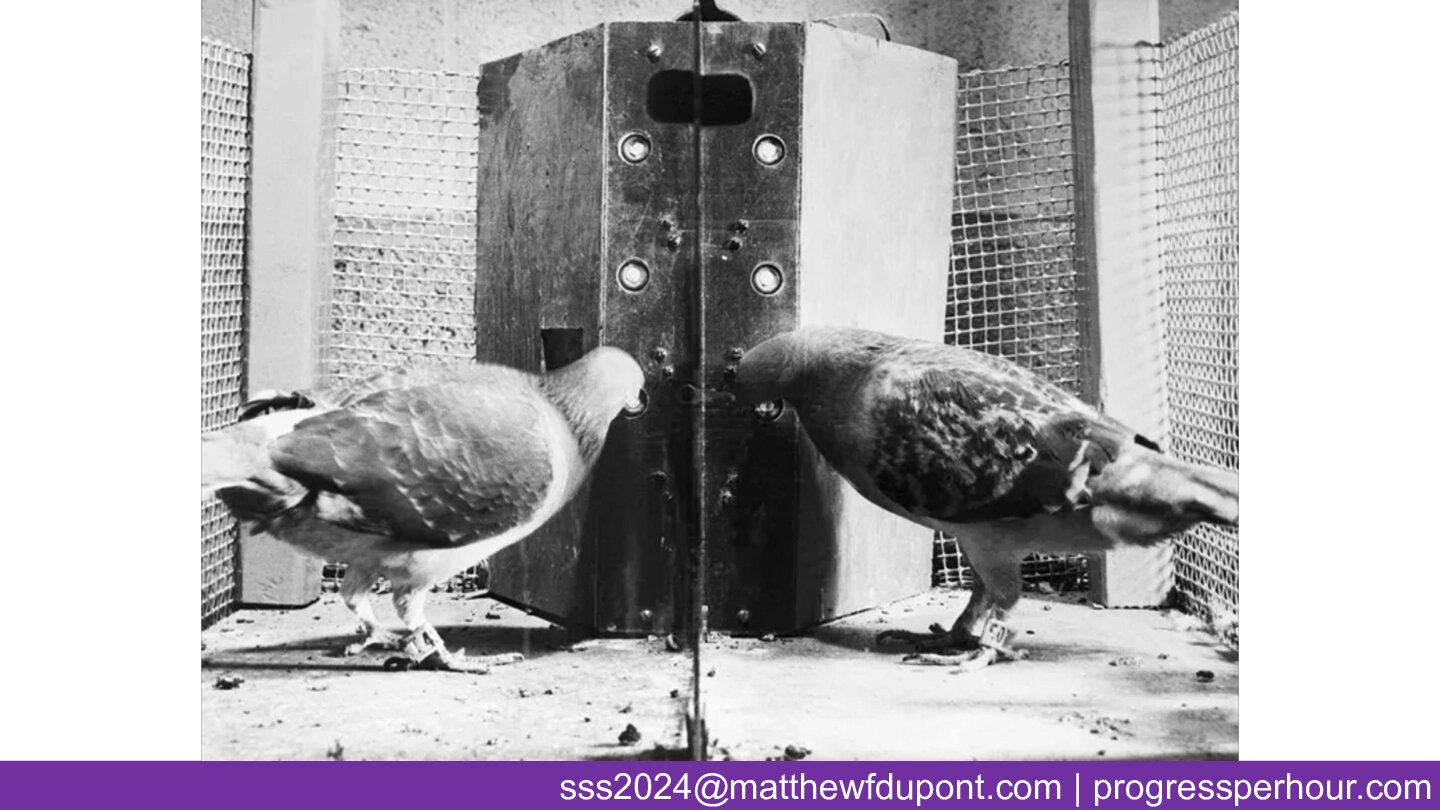
Specifically, in the 1930s, BF Skinner was interested in animal behavior. His lab built cages for pigeons and rats where the animals had a button that they could push to dispense a pellet of food. What the research found is that if you make the button only work some of the time, then the pigeon and the rats will keep playing the game even when they're not hungry. They get more food than when the button simply works every time.

This is known as a variable schedule of rewards and it works really well on people too. It's that feeling in your stomach when you scratch off a lotto ticket, or swipe on a dating app, or a new inbound lead comes into your inbox. That feeling of possibility: I don't know if I'm going to win or lose, but the wheel is spinning right now. And this feeling is the exact opposite of being bored with a sucessful routine.

Right now variable incentives are part of your life because big companies try to make you lose more money gambling, or spend hours doomscrolling social media. Instead, I propose you deliberately use this system on yourself to accomplish your goals. So I'm going to show you what I've been doing to myself for the last nine months, as well as a much more accessible system if you want to get started with it.
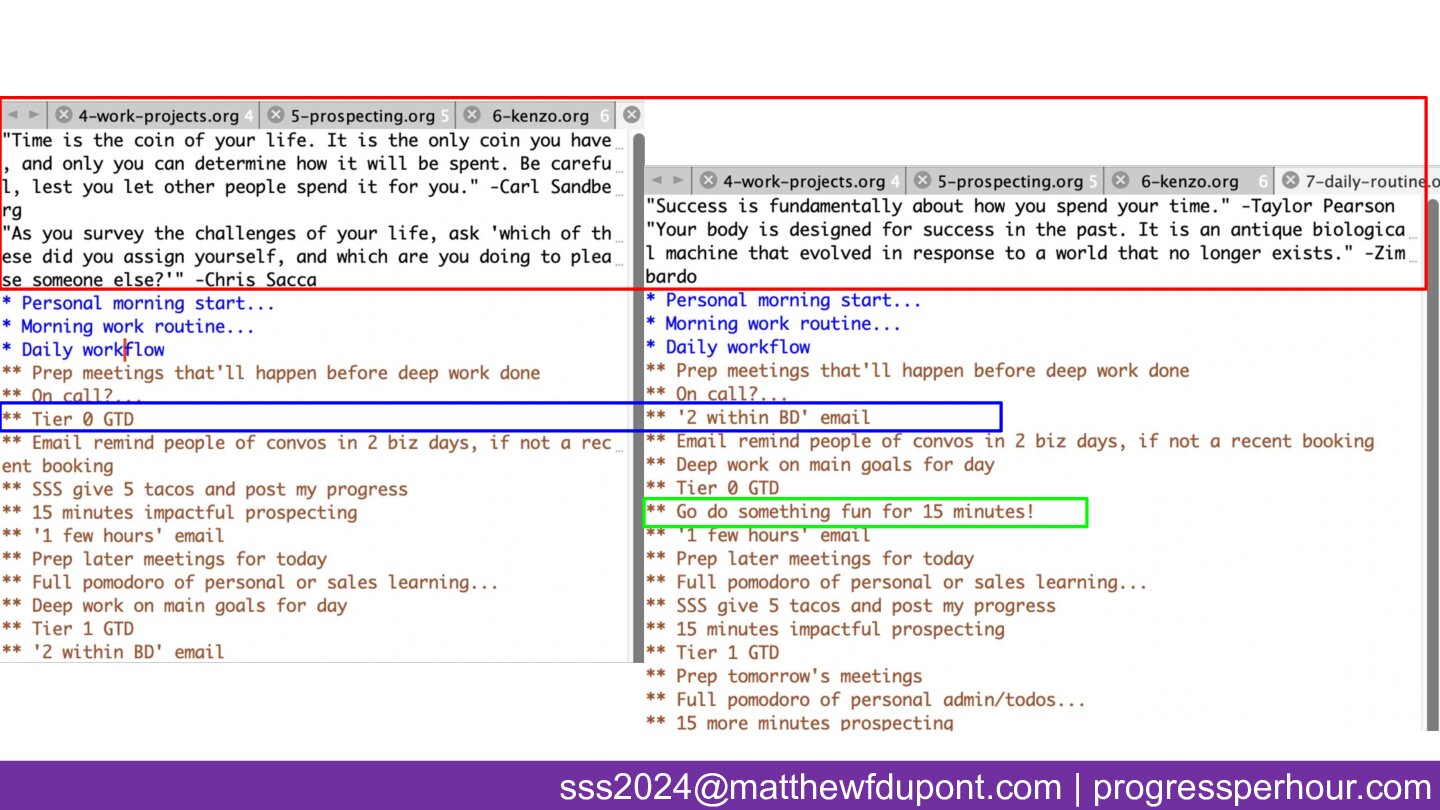
These are two actual outputs of my daily routine generator. I have a different daily routine that randomizes every day.
In red, I have a library of quotes that are different every day, so I don't just skim over them. In blue, you can see that my tasks aren't ordered the same way every day. And in green you can see there are some rewards like little breaks that happen some but not all days to keep them more fresh and interesting.
A system like this is way too much commitment before you build a simple habit. So I'd recommend you start the same way I started.

There's a simple way to try out randomization on yourself and see if you like it. Get a piece of paper and a single die (or random number generator), number the paper one through six, and write down some tasks you should do today next to each of the numbers.
Already as you're filling in your tasks, your gut will realize there are some of these you want to do next, and some of these you've been avoiding. Now you roll those dice, see what task you're doing next, and feel how you just had a "win or lose" gambling experience.
And then just do that a few times. Maybe that feeling helps break up that energy trough you experiencing some afternoons. So after a few rounds of this you're ready to take things a little farther.
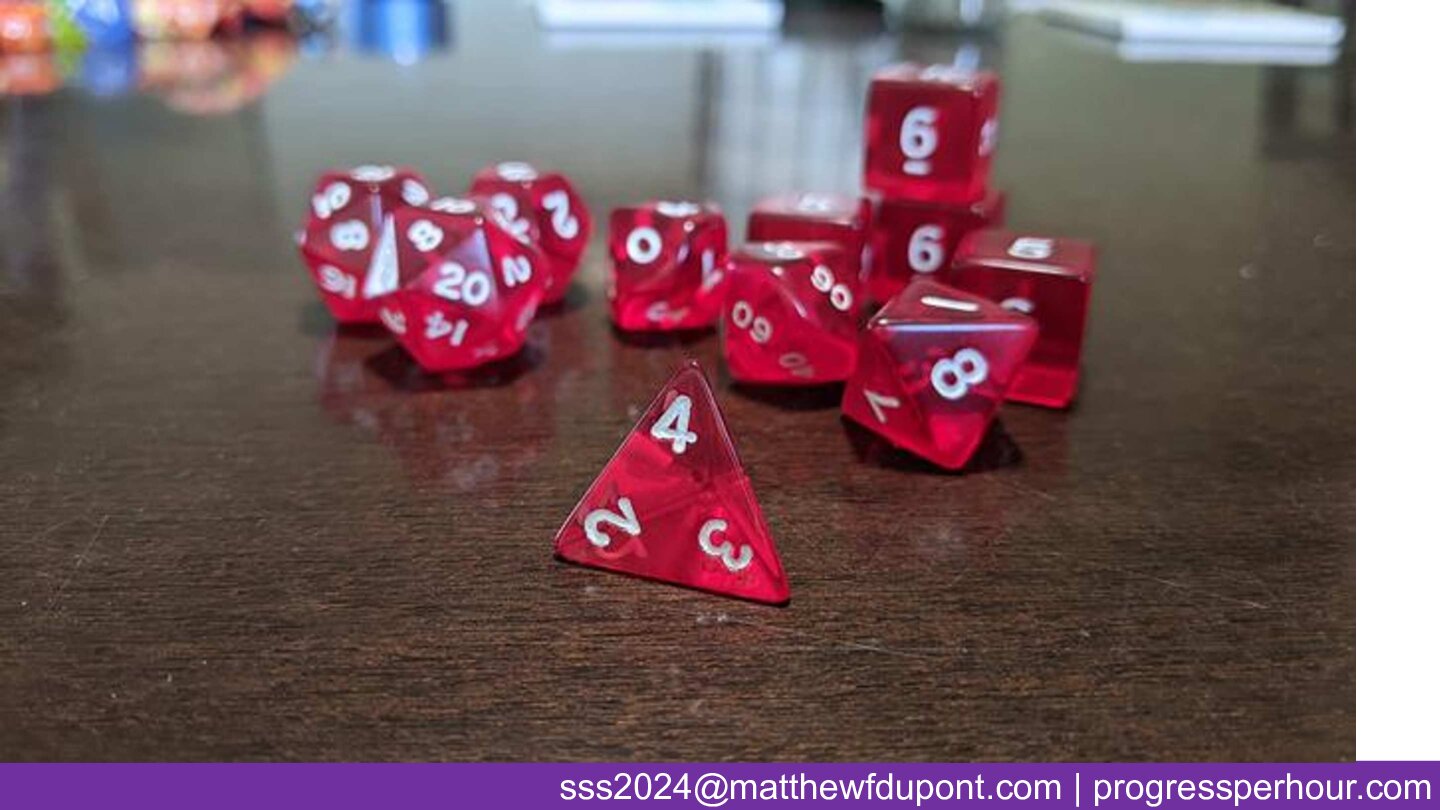
So find your local Dungeons and Dragons nerd and get a four-sided die. You roll a one, two, or three? Sorry, you have to work. Roll the six-sided die again like you did before and pick a task.
But you get a four, take a five-minute break! Now we have a simple system for using gambling's variable rewards to help be more productive.
Wrapping up this topic, what I've shared here is just one solution, and maybe it's a crazy solution or you don't like it. But there is a really big problem you should be conscious of here, which is that you're more likely to get bored when you're making the most money and spending the most time with your family in a job. If you're already successful in your role, and there is anything you can do to conciously help yourself stay in that same job where you're just harvesting your gains for a year or two longer, you should treat figuring out whatever makes the "grass on the other side" less greener as a really high priority if you're looking at sales as a five or ten or fifteen year commitment.
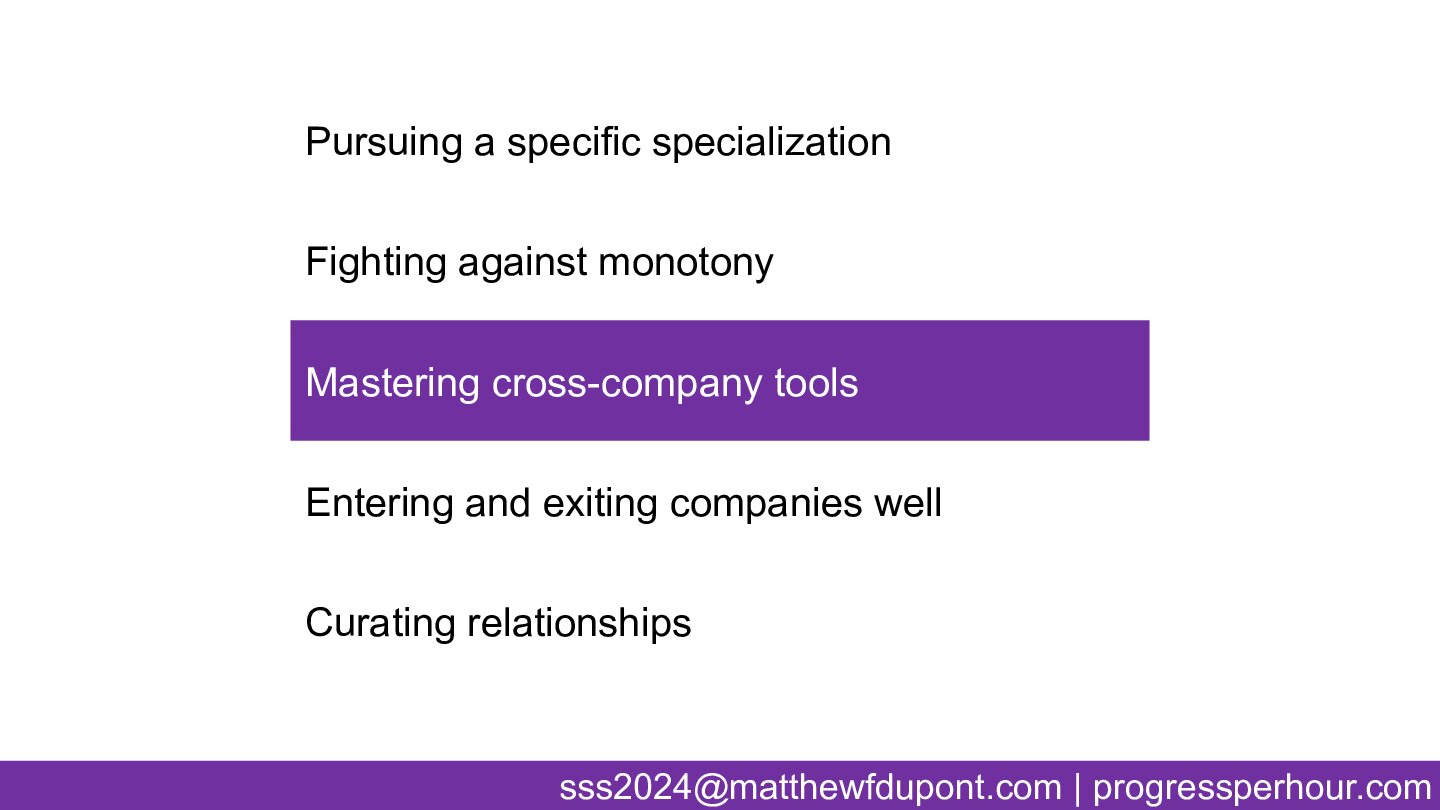
So now let's talk about tools.

There are two categories of tools: tools you control and tools set by your company. Tools you control are systems you can bring from company to company to company to company, and any improvement you make will be part of your toolkit forever. Tools set by your company are things that you'll be handed when you arrive somewhere: the CRMs like Hubspot or outbound tools like Outreach that might be different in your next seat.
We've talked about to-do lists already, so I'm going to talk a little bit about playbooks and text expansion next. As a note, though, there's a whole set of other tools you can improve that will reward you for the rest of your career.
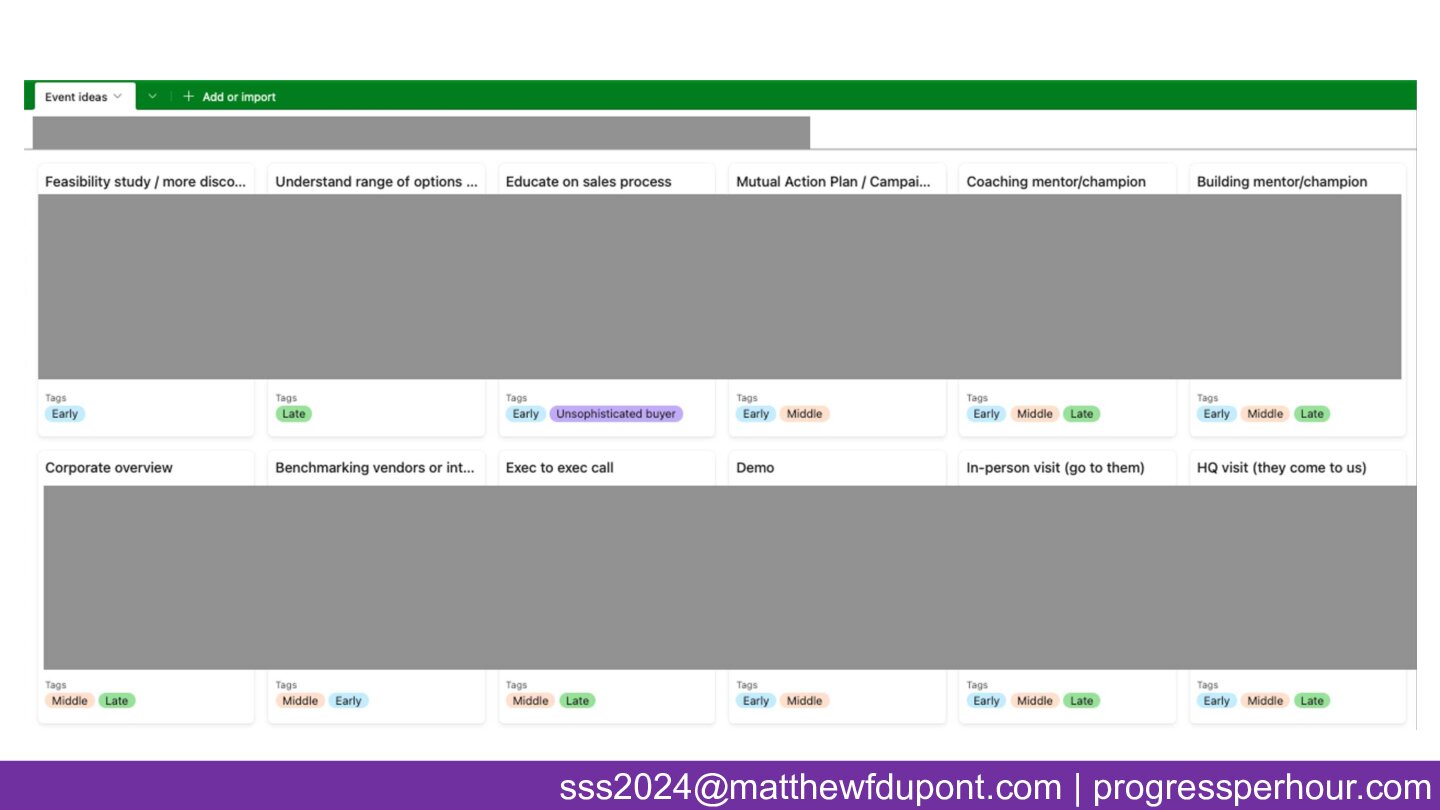
Let's start with playbooks. My memory is not the best. I don't remember everything I did on every deal during the years I've been in sales.
To help avoid the mistakes of my past, I use an event library: several dozen possible actions I can take during a sales cycle. This lets me brainstorm with my past self about stuff that I've tried, and recognize what might be applicable for the deal I'm considering now.
Side note, these are grayed out because if I put a thousand words on a 30 second slide, no one's going to listen to anything I say for the rest of the presentation.
Another important theme around playbooks, and this is so much less sexy, is just having really simple checklists for everything. Even things that you think are so easy that having a checklist for them makes no sense. These could be for when you close a deal, when you set a forecast, when you finish a meeting, anything.
And you're probably thinking, "okay, I'm pretty senior, I know how to do that stuff, I've done it a thousand times, who cares?" But the thing is, people like me that have that checklist, we learn really easily from conferences or books or other reps, because to modify my behavior I just need to edit a checklist that already exists which I'm already trained to look at. For you to try something new, you need to remember it at the right time at an uncertain point in the future, so odds are good that folks with checklists are learning way faster than people excited about a new idea now but struggling to remember it at the right time 17 days later.
So yes, you might know how to close a deal, but if you want to improve over time, you might want to make a long bet in modifying your own behavior. Make yourself modular, so you can swap out the components that are less effective as you go along and learn new things. You can bring these lists from company to company and get way better over time.
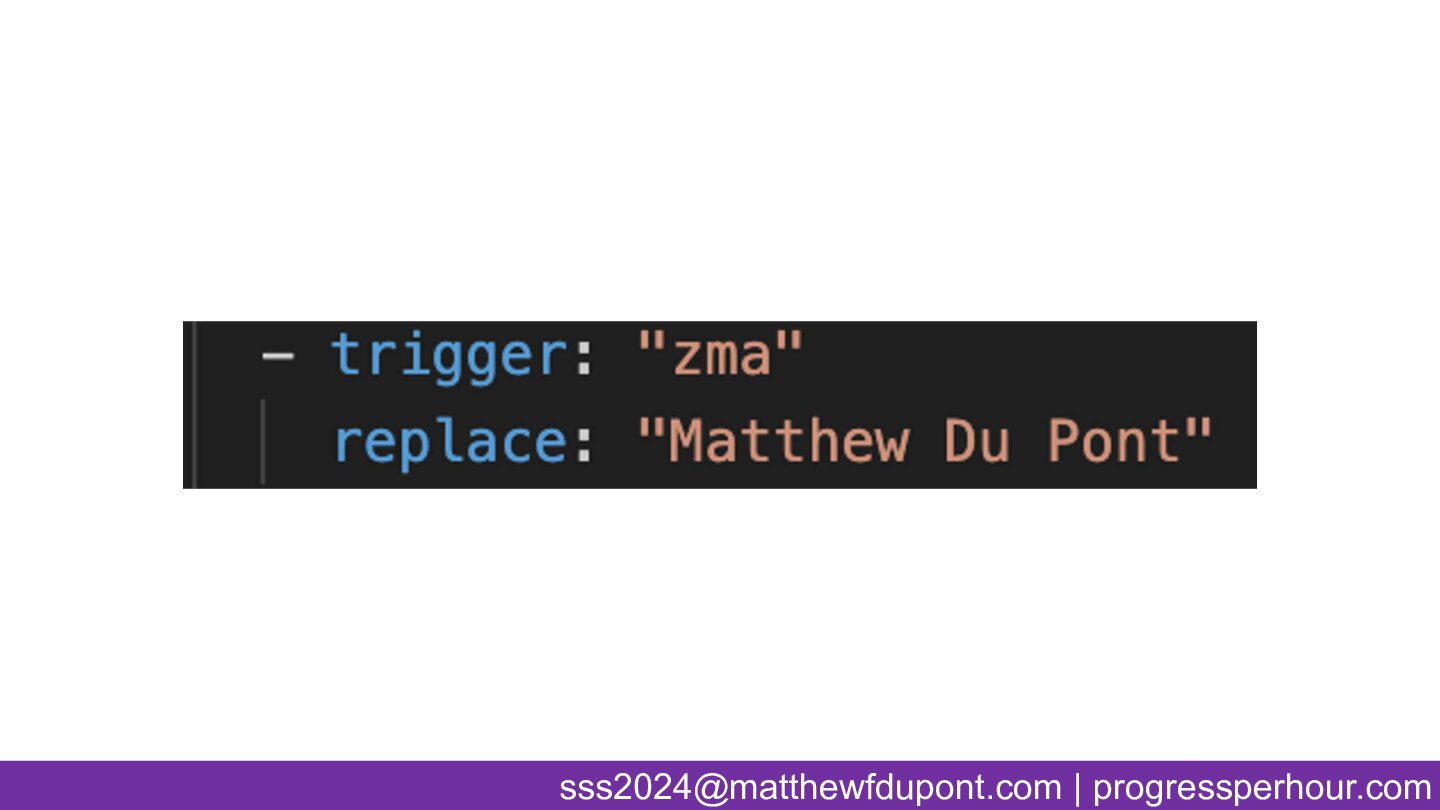
The other piece I want to talk about is text expansion. This is a repeat from my 2020 talk, because I love it so much. It's a very simple idea: you type something, and something that takes longer to type or remember appears immediately. This works on your whole computer: your browser, your email, wherever. So I don't type my name anymore, I don't know how to spell my name, it's "zma".
Think for a second about how many times you've typed your phone number, your company name, all that stuff, that's wasting time. Like you should be typing about two characters for that. And the time savings from this really adds up.
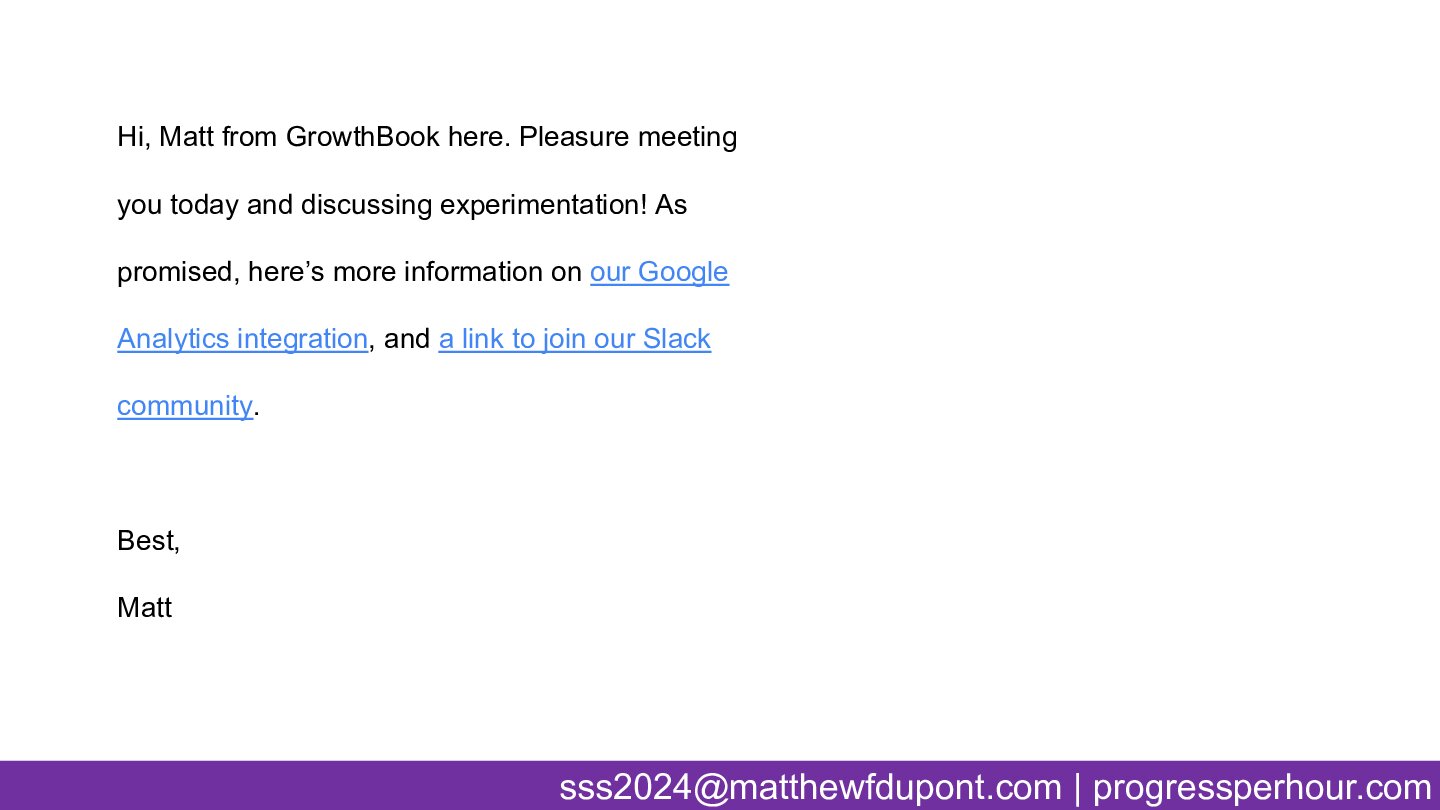
Here's a follow up email, which is oversimplified for purpose of this conversation.
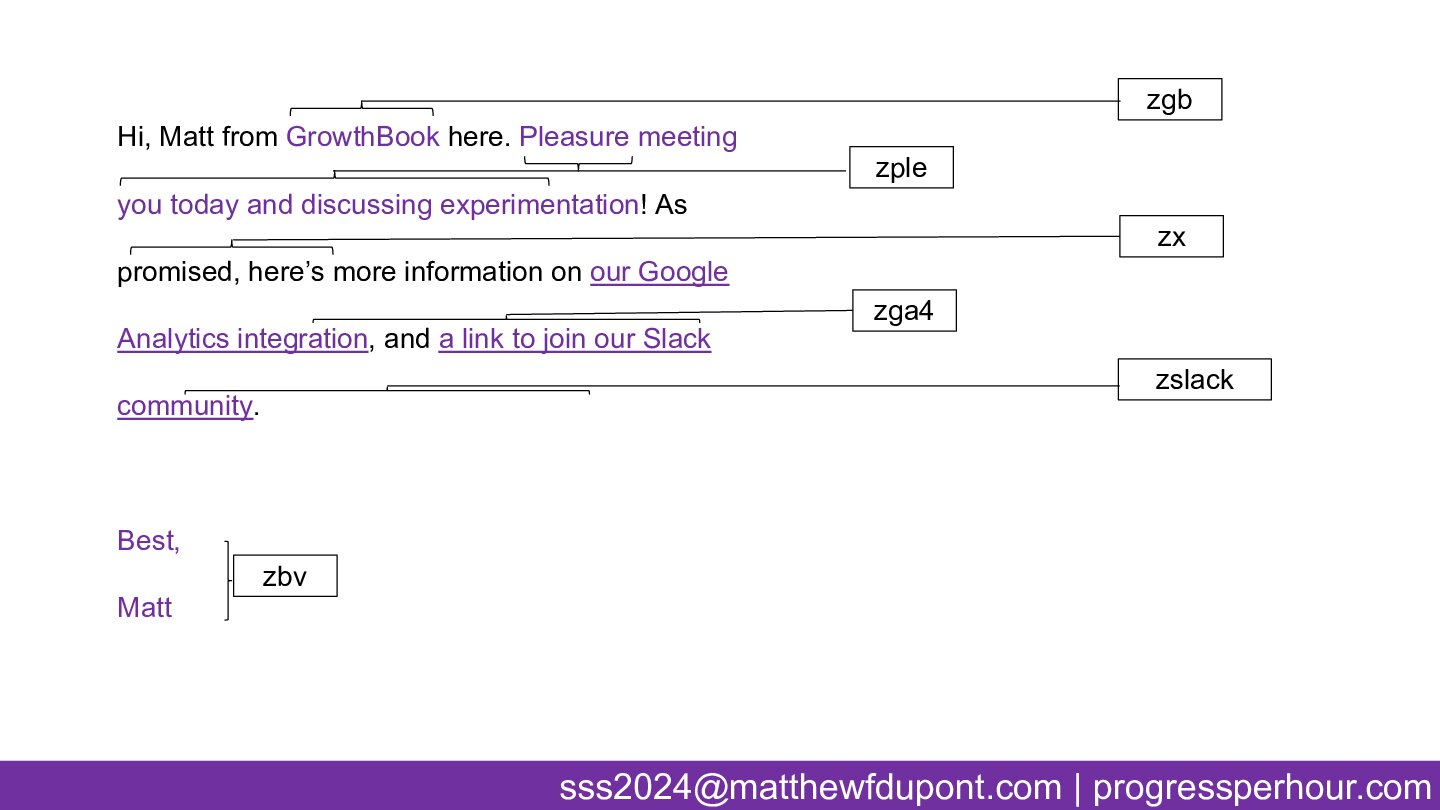
And here's how I actually type this email. All the words in purple are inserted when I type these small snippets which I've memorized. This especially shines when you have any kind of technical buyer and they want links to documentation, which is time consuming. Overall, when I've timed typing both of these emails, I save 40% of the time when I'm using text expansion.
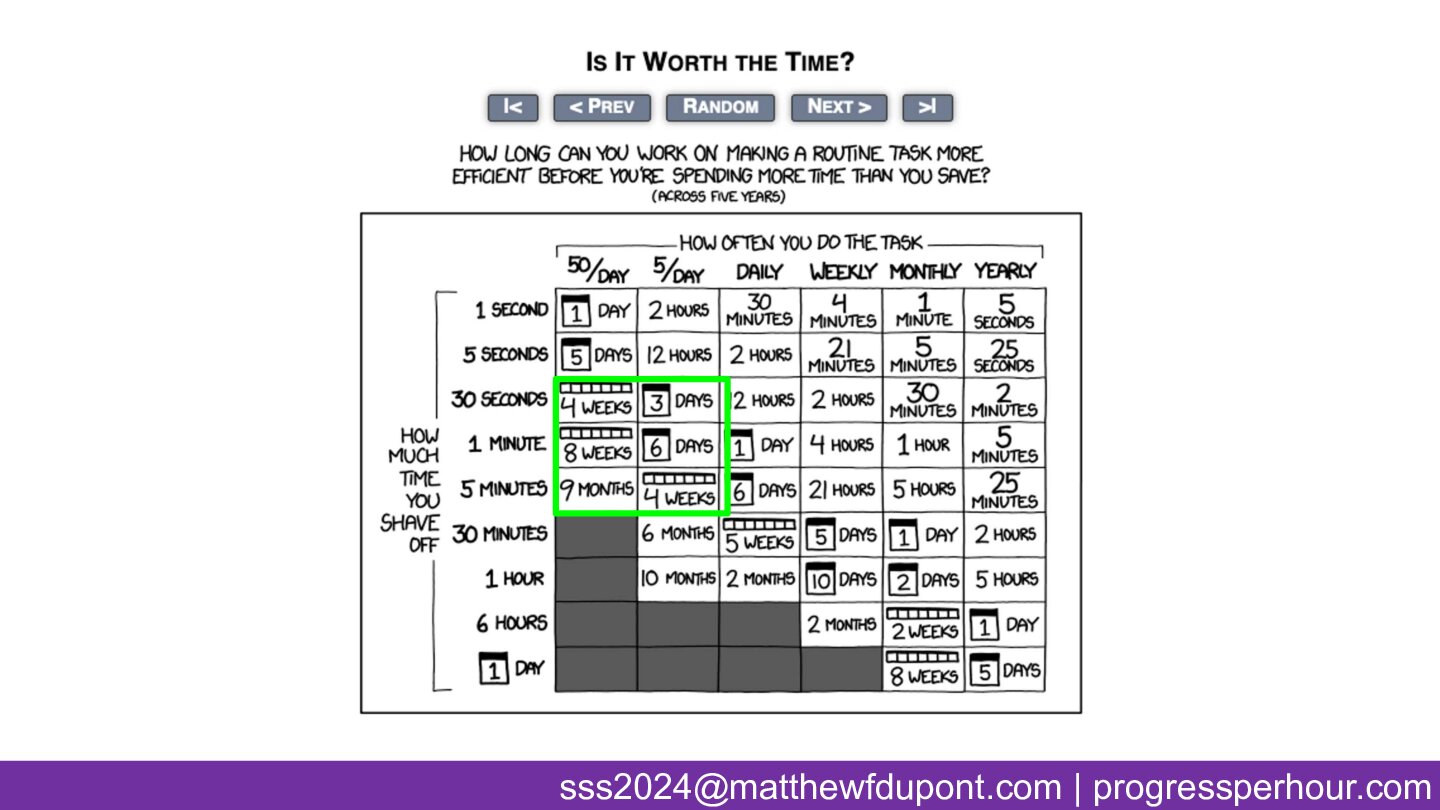
You're going to send 5 emails a day, and for each email this system would save you at least 30 seconds. Those are hyper conservative assumptions. If you believe those assumptions, then over the next five years, you get three days of your life back by using a text expander.
What really matters, though, is that ease of completion lowers the activation bar for a task. If following up goes from being 15 minutes to 8 minutes, when you're really tired at the end of the day it's a lot easier to do one or two more. On the margin, you're going to do more work, not just save time.
In the interest of speed, I'm not going to get into super detailed tool recommendations. I recommend Espanso if you're a little bit technical.
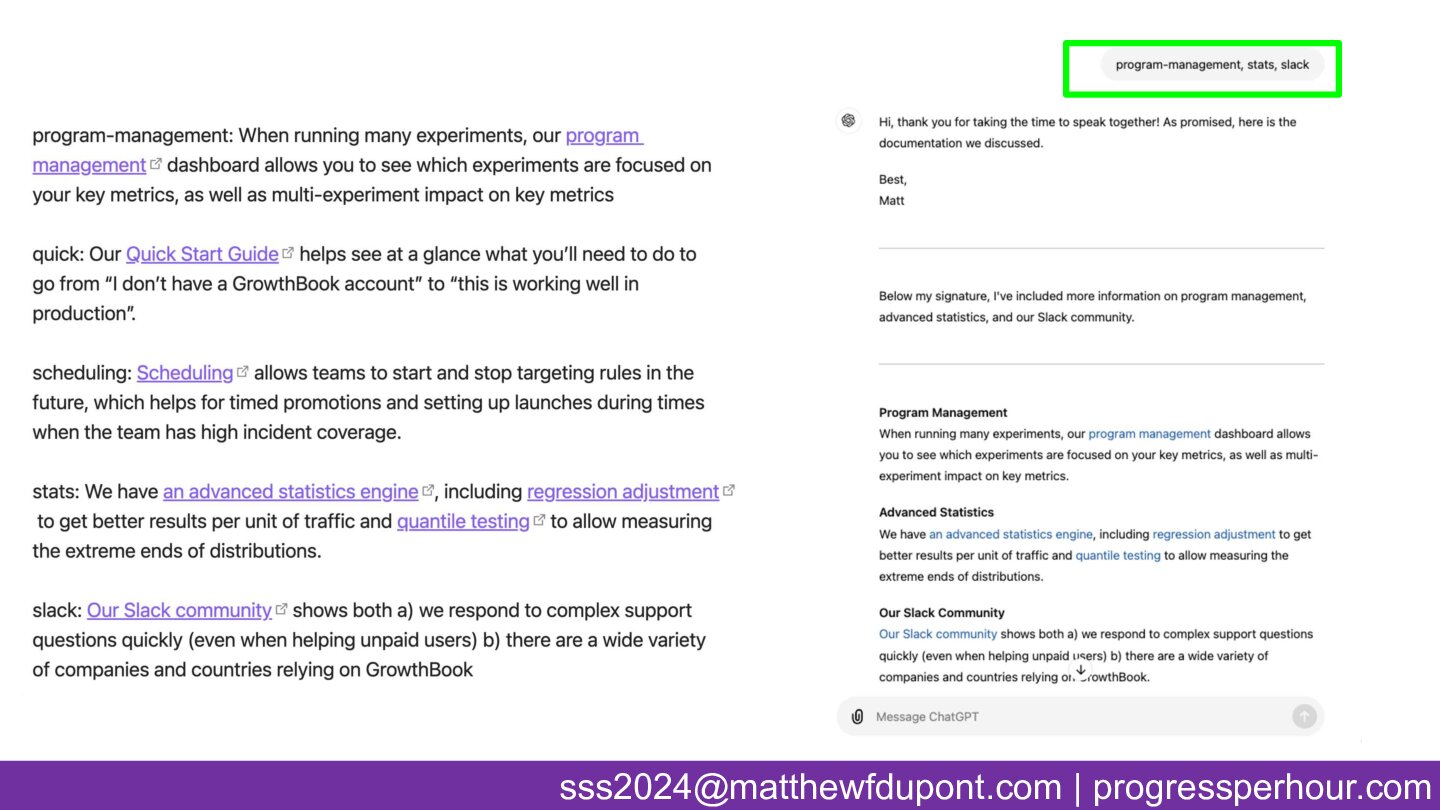
And then finally, generative AI. Sorry, this is like very zoomed out.
But if you send complex follow ups, you don't want to have to memorize 40 different things. So the 40 different things, your engineers, your product manager, your marketers, or whoever might ask you. So I've set up a prompt where finally it stopped trying to rewrite what I've written.
I feed in 30 or 40 different snippets on the left side as part of that prompt. That allows me to put in an input shown in green at the very top right, so that it's gonna print out a good first draft of a template with all those references I need. So if you talk to the kind of buyers that wanna know like three or six or 12 things every conversation, this has massively made it easier for me to get this done faster and follow up within an hour or a day instead of like, oh, I'm intimidated by the half hour brainless work I have to do to do all the stuff I promised.
So if you're not using GPT for follow-ups yet, I'm happy to share the prompts, but it's been just made my life a lot better in the last six months. So sorry for the speed. I just care very deeply about you all succeeding and I'm trying to like get as much in here as possible.
I'll try to breathe a little bit. Next thing is on entering and exiting company as well. And I'm not trying to give an overview here.
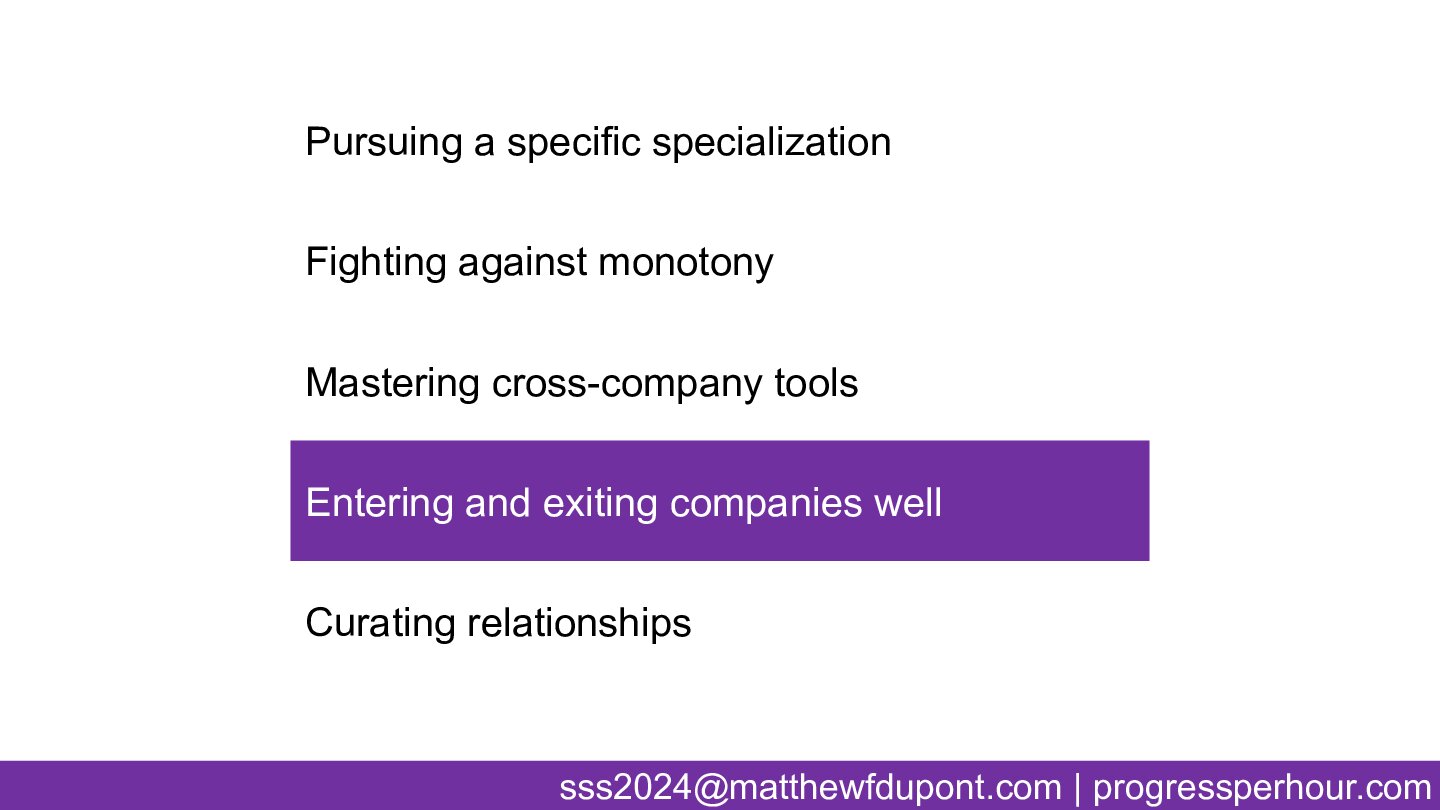
I'm trying to say a bunch of weird stuff you might not have thought of. But again, what are the things that we can do that play out on a long time scale that help you either pick the right job or quit with grace? So first of all, let's talk about passive recruiting.
This is when people are hitting you up. You've been in the world for a while. You know, maybe after like a four or five year mark, I started getting a lot more messages.
As you can see by the time stamps here, I'm sending a stop message out maybe three or four times a week. And I did the same message for about six months. So, I want to tell you what worked about that and what didn't work about that.
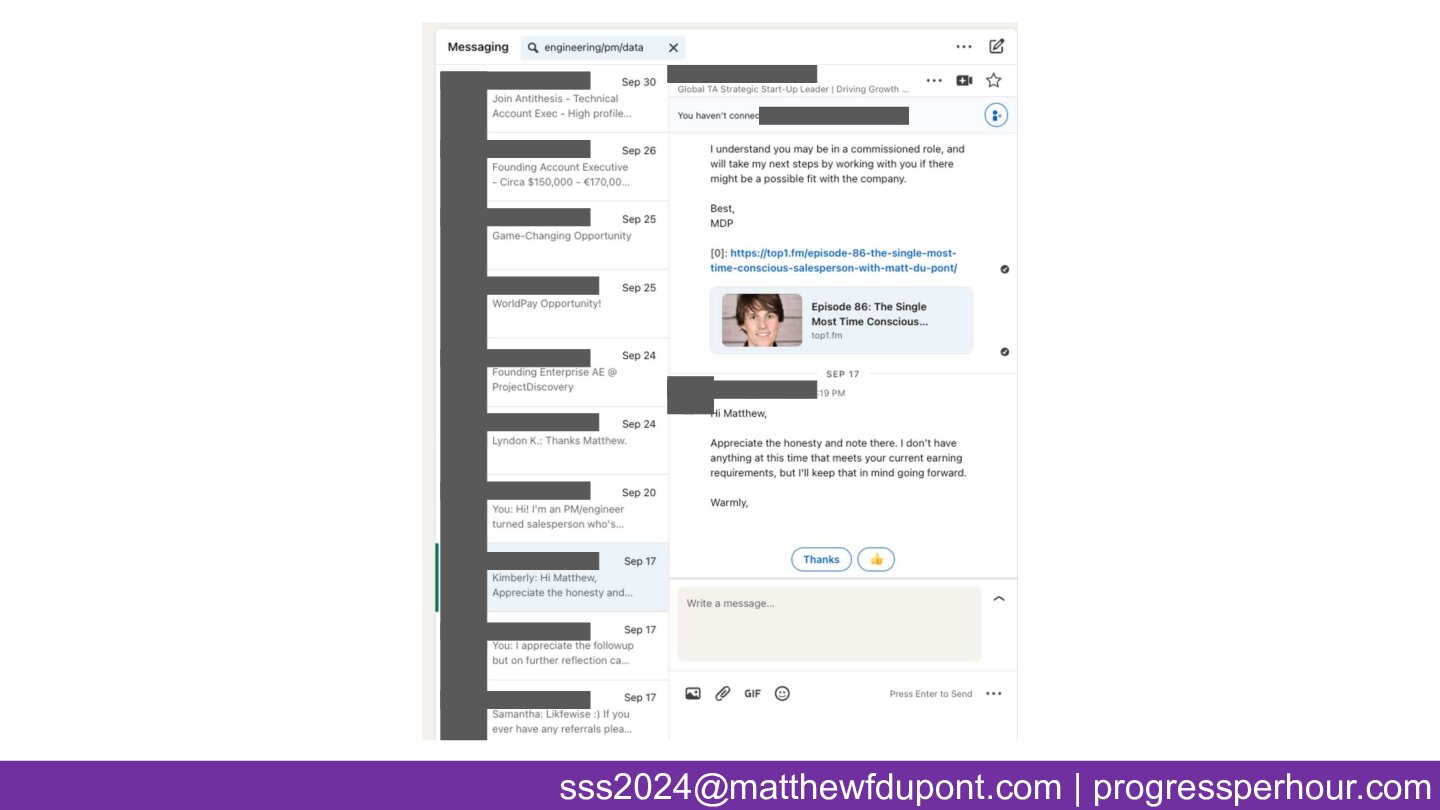
So, you can adjust your own practice. So, ton of text on this slide. Sorry, we'll be here for about a minute.
There's some things that worked and didn't that I'll call out here. But basically, I start off by saying, you know, bragging about myself and you'll brag about yourself in a new and exciting way. Then I qualify really hard about what I'm looking for in a role.
And then I ask them to send me a bunch of stuff before I'll ever consider getting on the phone with them. Now, the three things that worked. Saying you're a buyer high enough that the recruiter reads it.
Let them see themselves through the door. Because otherwise, if you're like me, you'll start getting distracted. Like, it is a really cool tech.
It's not quite my buyer. So that's not just to have the recruiters qualify themselves out. It's so that I don't get tempted by CFOs if the tech is really cool.
Setting a specific dollar amount that you're looking to talk about before you have a conversation. This is a sliding scale based on my happiness. I am happy at Growth Boat right now.
There are many, many 300 to 350 OTE senior AE roles where I'm like, you know, at the top of the enterprise but I haven't gone into like super strategic giant deal stuff. So that's for me in my career stage, this is pretty high. If I was not happy at Growth Boat, this would be a much lower number.
But the nice thing here is this helps screen for people that have actually done research on your background and want you specifically for some particular reason versus I am mass sending messages to AEs with at least X amount of experience. The people who are willing to pay you more usually have a reason to do it. And those will be the interesting conversation to read the leadership right away.
And might tempt away from a role even if you're very happy right now. And the last piece, the seeing small, but the lowest thing on the slide number three, I started getting a lot more detailed responses when I started telling recruiters, hey, I'm not going to take you out of the process once I know who the company is. They want to hide it because they don't get paid if you go around them in a supply to the job, so showing them, if you give me the info, I'm still going to work with you, led to a lot more info before the calls.
And here's what doesn't work, that I'm going to take out of the email after this presentation. I've been doing it just to let you all know. No one knows the thing about equity when they're a recruiter.
Doesn't matter too much if you're a big company, matters a lot if you're a small one. And if anyone, number five, if anyone can please figure out the trick to not get on a worthless 10 minute call with a recruiter before you talk to the people at the company, let me know. I have tried so many things, they have not worked.
I've sent like frequently asked questions about myself, I've done all this stuff, they need to get on the phone with you. So just find a time you're exercising, take the call when you're unabashedly doing something else, and save your intent for when you're talking to someone working at the company. Sorry, sitting next to the headliner, so I feel like the thought of yes.
If I ever go into construction, I'll disavow my rules for pride. So yeah, this might help you if you're passively looking. If you're actively looking, you throw all this out the window because you need a job, you need to be paid.
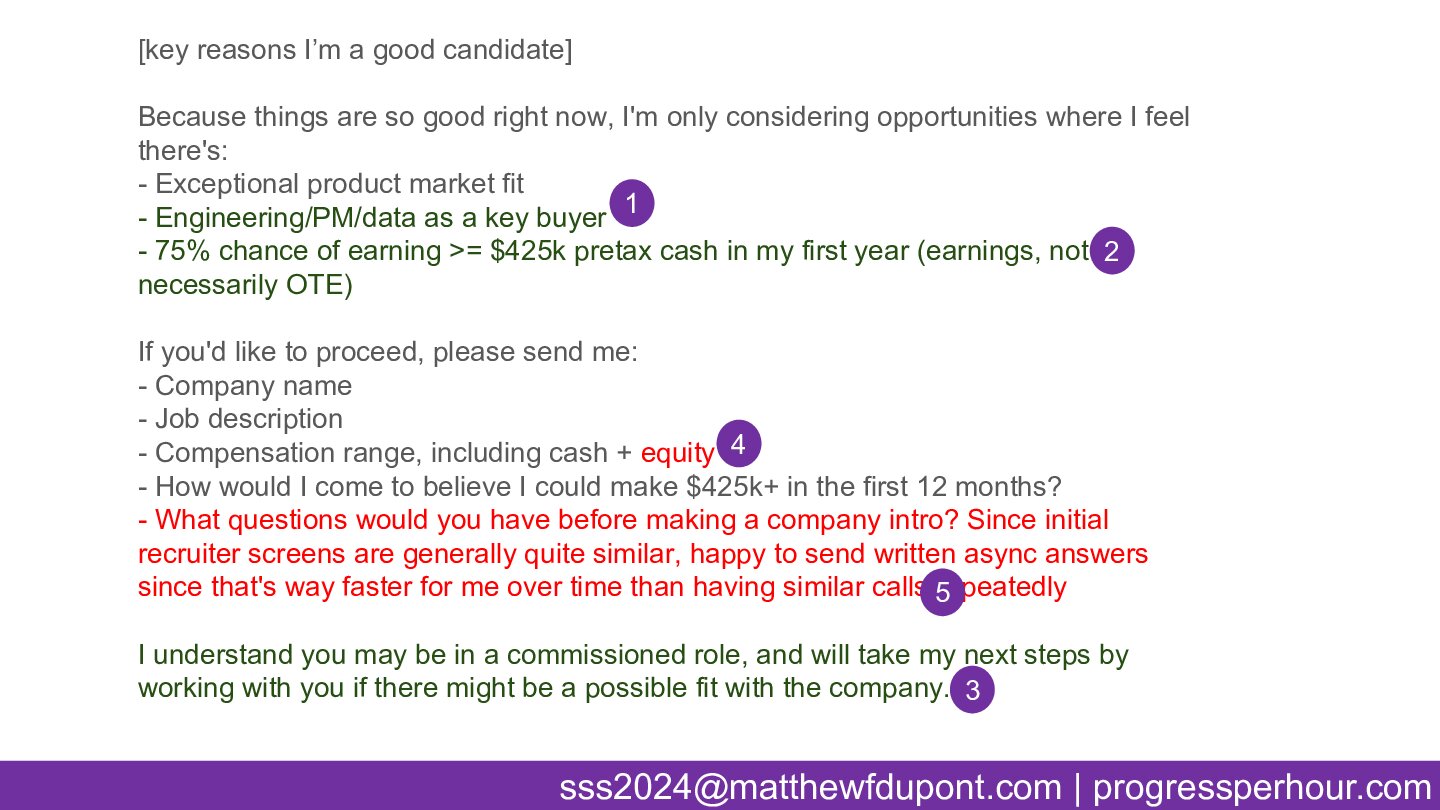
I wrote a book on that in 2018. I pay while at the time. A bunch of people bought it, no one refunded it.
Presumably, it's at least somewhat okay. There is no lead in to a course, there is no email list. I don't know of a catch.
The one thing is it makes you feel very warm and fuzzy inside if I help anyone. So if you use this and it helps, please send me a message. There's notably good stuff in there about how to figure out what stories you should be telling and how to manifest those in your resume.
I think it might be useful if you're searching, but that's my tip in 30 seconds that you're actively looking. Maybe I said something smart. Maybe I didn't.
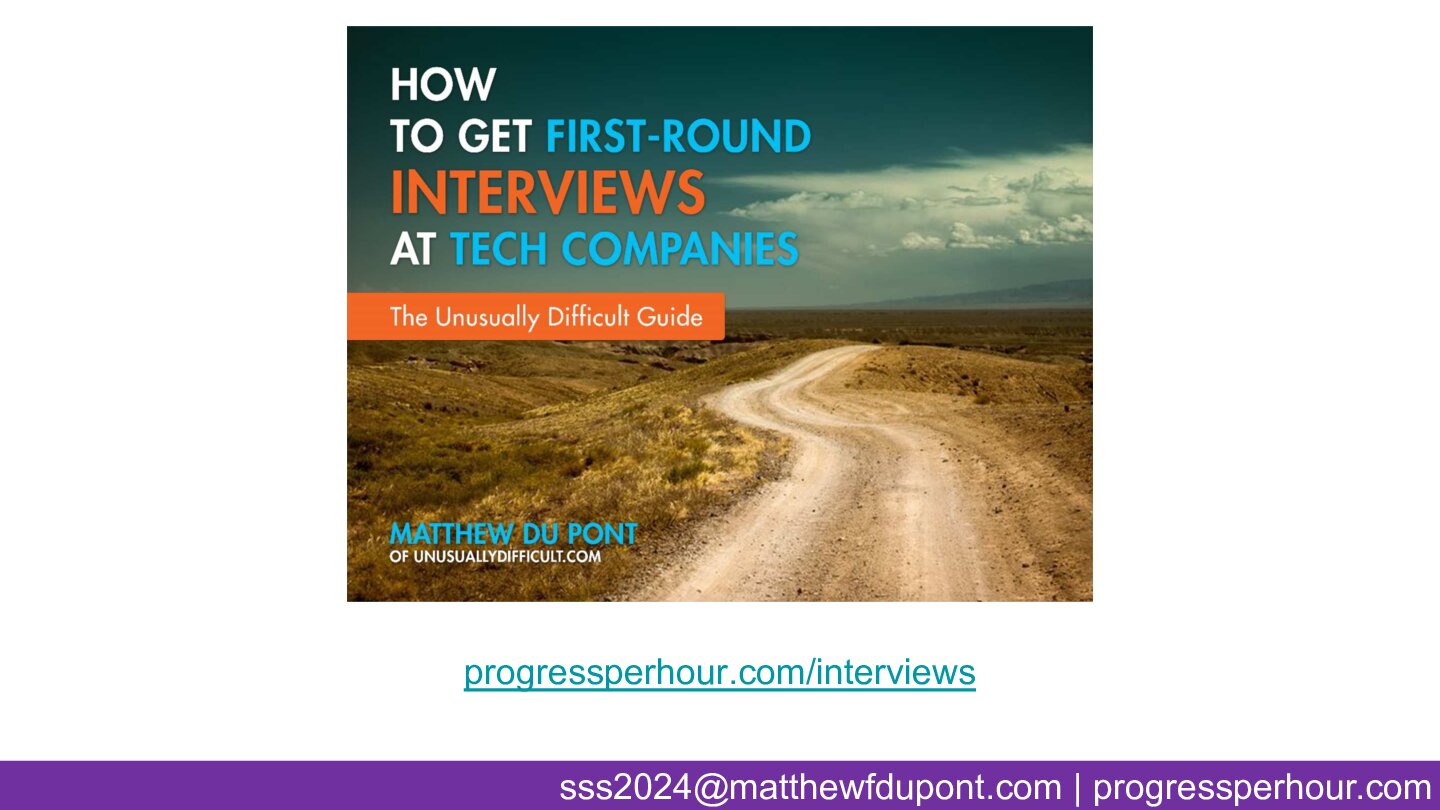
The other thing that applies to anyone starting a new job that most folks don't think about is your invention assignments. So when you're speeding through paperwork as you get to a new job, one of the things that you're gonna sign is gonna say, hey, if I think of something cool and I'm working, the company owns that. And I don't get to like sue them when they try to IPO.
And most people was blazed through this in the interest of not making any waves. I've been the first person at the last three companies I went to to have inventions. And some kinds like, even like rippling is like, what are you doing?
This is not an edible field. But it's never hung up my application anyway. And so if you are bringing some of these awesome playbooks and strategies and resources from other jobs, I don't know what the chances are getting seized and assisted or that company getting into a struggle with you later.
But I feel a lot more secure sharing with you all here and being open about getting feedback from other people when I had at least some measure of legal protection that they don't own the stuff I came up with before I started talking to them. So I hope this never matters to any of us, but it's a low cost possible feature save long bet. Exiting is harder.
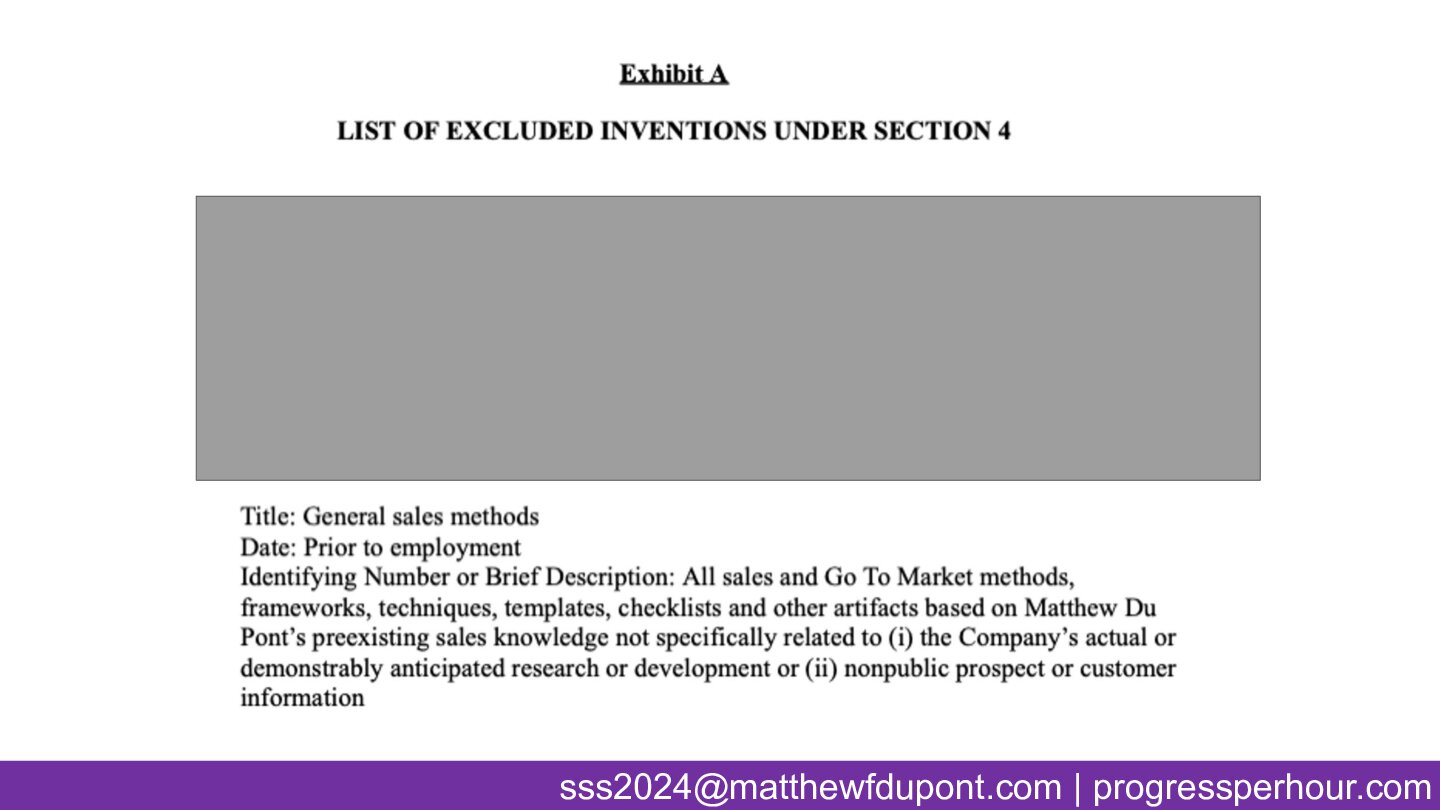
Most people don't think about exiting till they're quitting. But if you're not at the end of your career, there's like a 98% chance you're either gonna get fired from or leave the company or app. Your exit is an inevitability, plan for it.
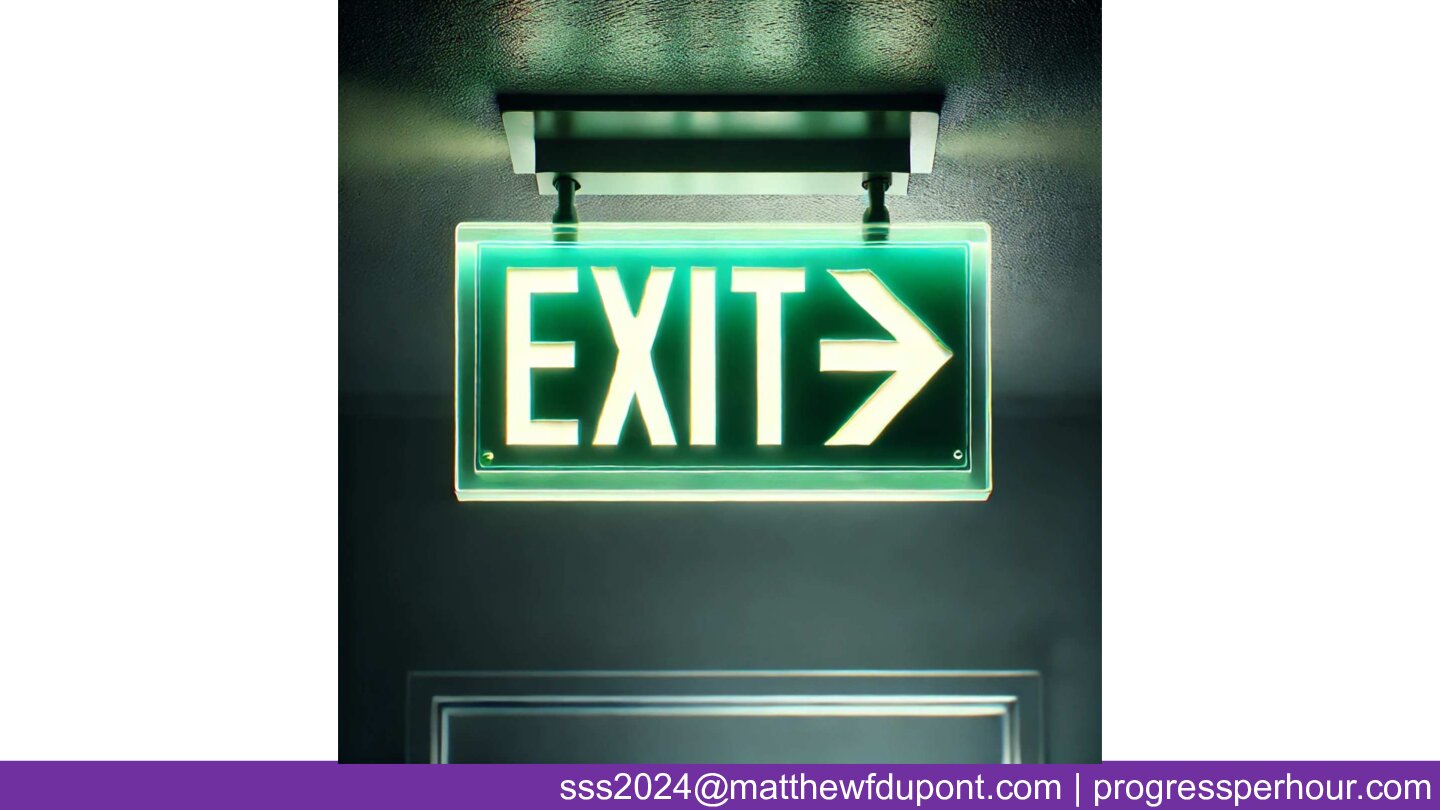
So there's a bunch of stuff you can do to make that exit way easier if you do it way when you're happy, way far in advance, versus when everyone's getting upset and you're heading out the door. Two that I wanna talk about are first, personal CRM. You should be keep, like when you meet someone that doesn't belong to the company, you've thought to this person, you know their kids names now, you know what their hobbies are, you know where they live.
Like you should be keeping that information if you're going to make any kind of a network based play and using it for your future self. And I'd argue like you should be trying a lot harder in whatever your system of record is for the next 15 years than the company CRM you're gonna leave behind in two to five. And so yeah, it's a super annoying long bet.
It's after every call or after every deal close, you're updating this. But it's way worse if it's like trying to remember every conversation you had when you were at the door. You know, God forbid you stupidly try to export the CRM and obviously it caught by IT.
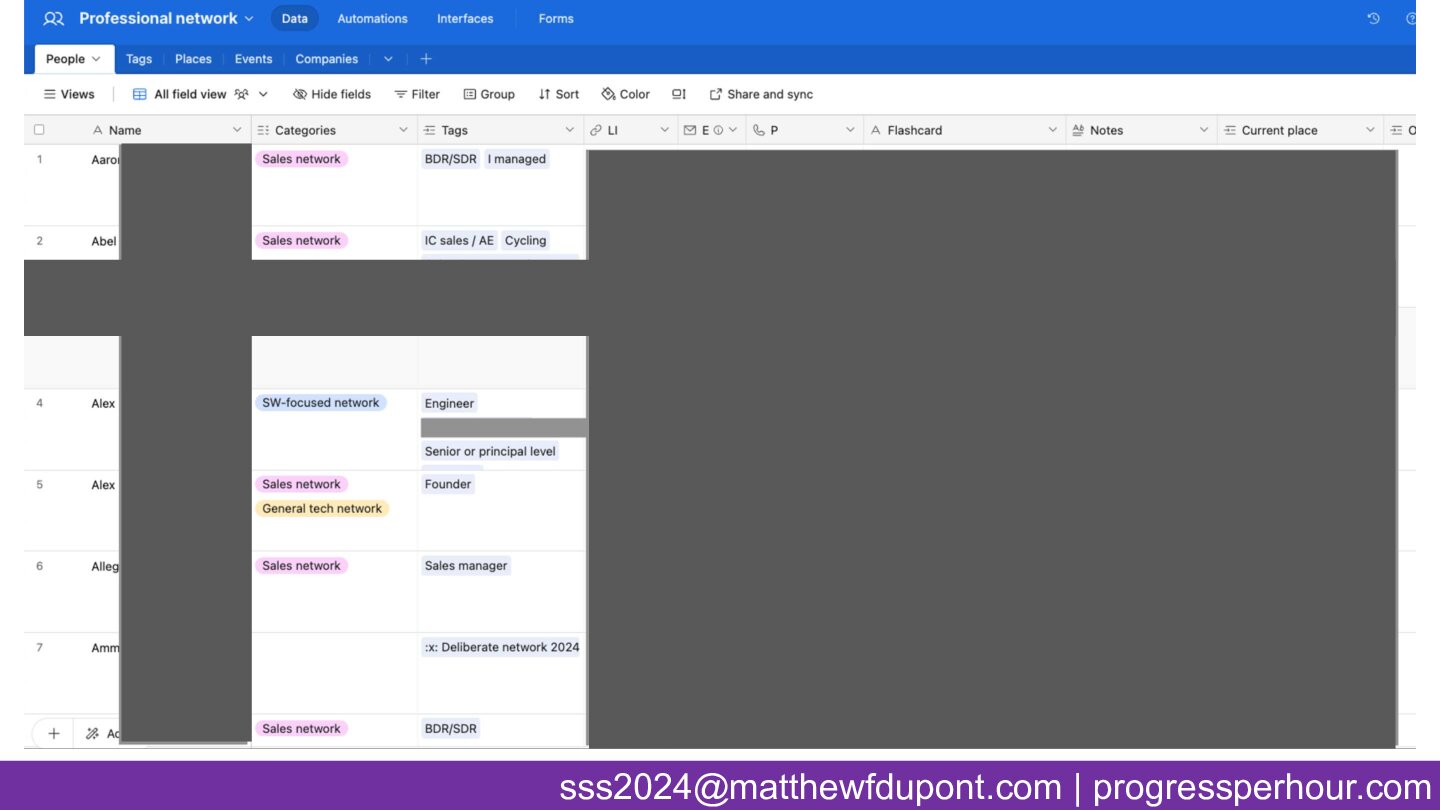
Like if you got away with that five years ago, like it's getting harder, I imagine. So like just do it right and keep this system updated. The other thing, I don't see a lot of people do this, is get C level public recommendations while you're still at the company.
It's a pretty tough sell when you're saying like, hey, I'm leaving, all these leads need to be handed by somebody else, you have this big problem of hiring someone. By the way, can you write something really nice about me online? Versus saying as you come into a job, hey, if this, you know, day one, I'm really excited to be here, I'd really like my first annual performance review to have a glowing LinkedIn recommendation if I've been doing a really good job.
Now, this is important because there's a lot of salespeople about their lying about their numbers. Everyone in interviews is a hero. Everyone was a never-going rep.
Everyone hit target. And the problem is that hiring managers, I've heard that so many times that when you actually have a good story, they don't believe you. Because why should they?
They usually lie to you about numbers. So having some degree of public acclaim backing up that you hit a certain number or a rep of a certain quality, really assist them in valuing you correctly. And as a side effect, when you do this, my current job will now only get my next one instead of I only get this recommendation once I've left and I'm gone for six months and it's all blown over, and then I go back to them to get the recommendation.
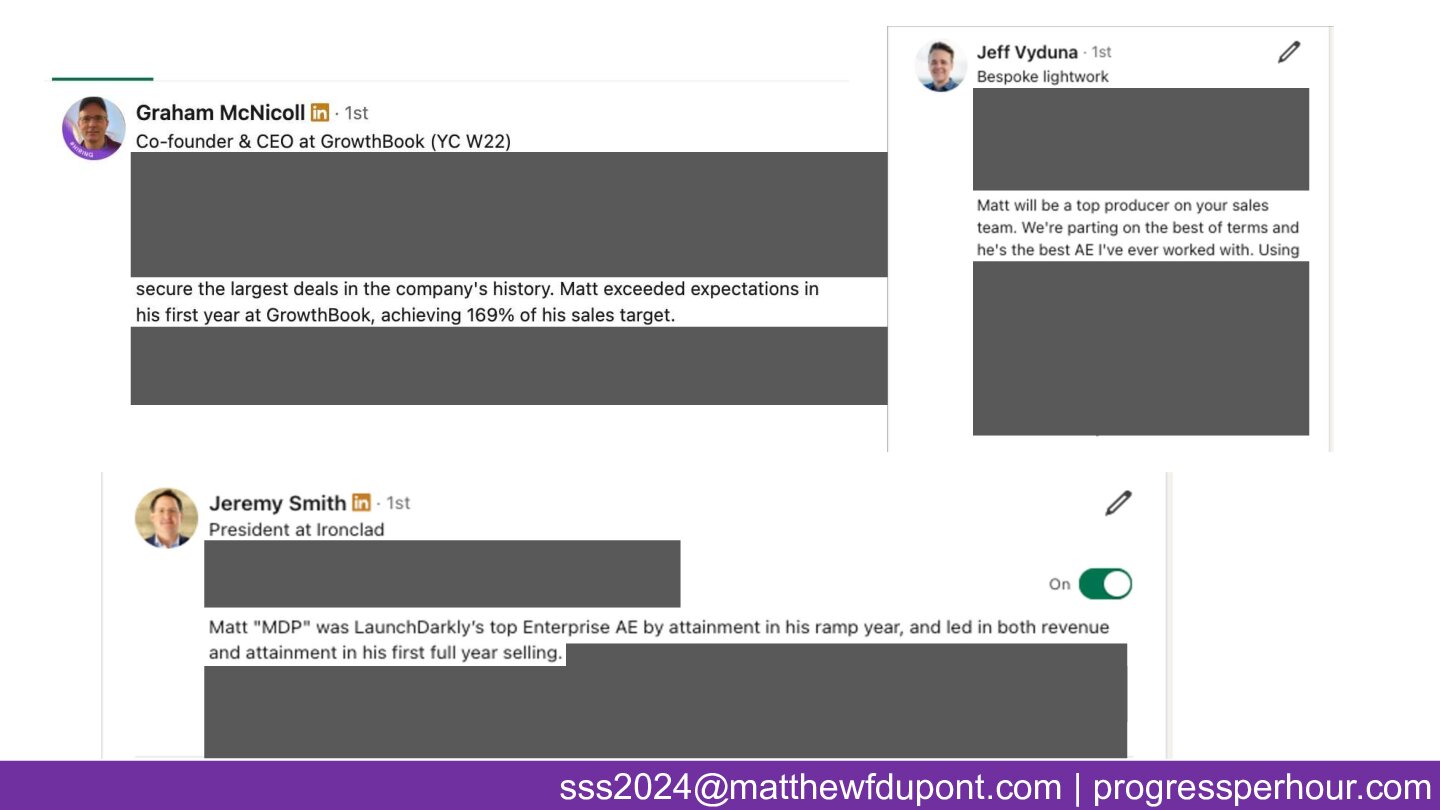
So especially if you're still advancing quickly through your career, you want that stair step working in your favor. So that's a bit on entering and exiting. The last piece I want to talk about subliminally is around curating relationships.
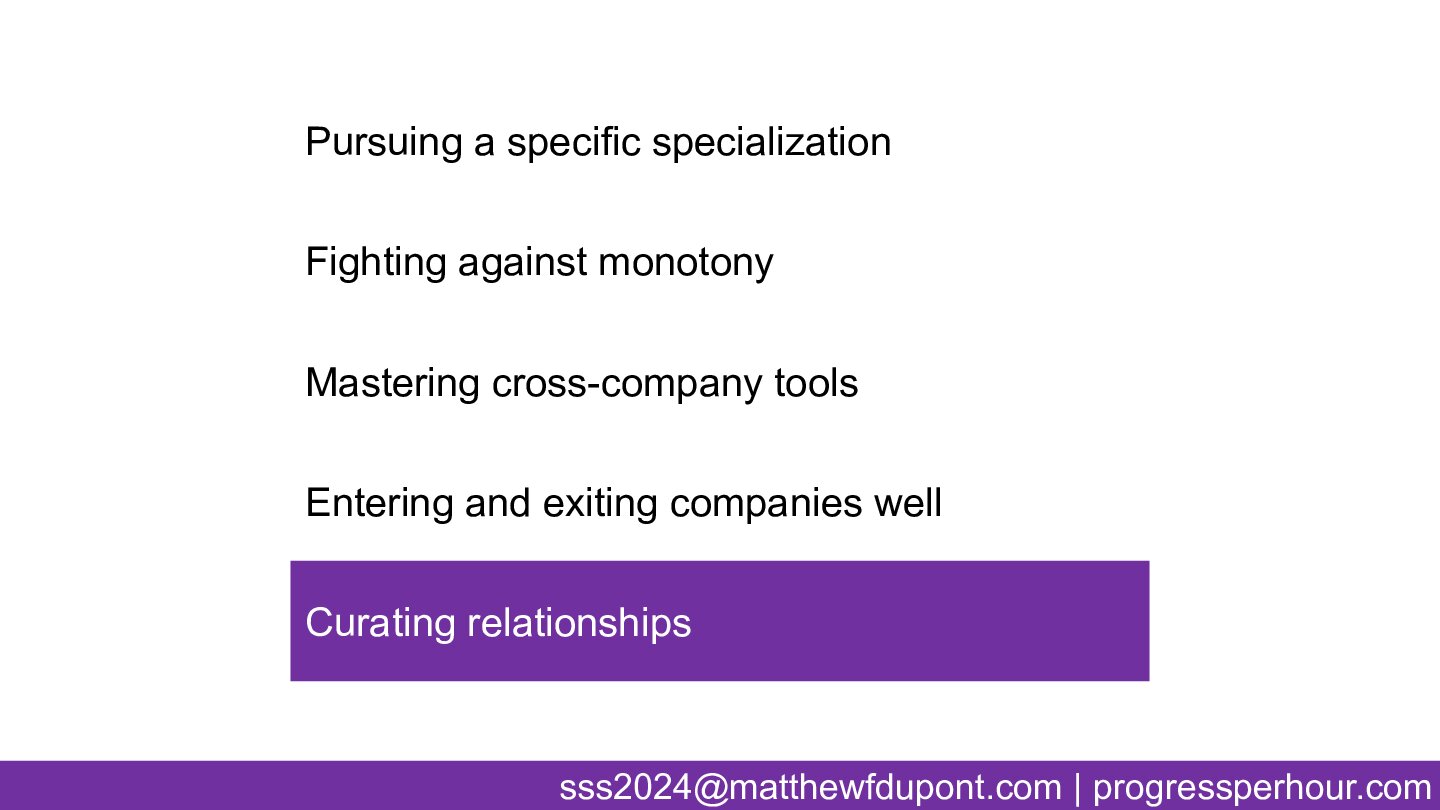
My big takeaways from 2023 summit were from Kevin and Leon, both of whom are here, both of whom know way more about long-term relationships than I do. So thank you both very much for helping me out. This is a bit of how I put your advice in practice.
And all the bad stuff is my fault, all this stuff is their fault. So one thing about working at small companies is super nice, is when Kevin talked about the referral program last year, about how he purposely had this giving mindset and built up a lot of people and started using that for referrals, we were able to build a program at our company very quickly copying that, where we started paying people outside the company that help us get deals. Leon had talked about not only showing your values to people or in the cycle, but using some proof of what of the work you've done in the past to show that you're a bit of a different breed when talking to a client.

So being your client's champion, leveraging on the future. So why does that is I made a website, and among other things on the website is a statement of my values, and pretty early in my deal cycles, I will say something vaguely uncomfortable to the people I'm selling to, and I'll say, hey, my master plan for the next 10 or 15 years is that if I'm unusually honest with you, and I unusually know what I'm talking about, which is not as common in engineering sales, might be more common in other sales, that I want you to be able to feel motivated to speak with me again. And my goal is that I can have a lot more time with my family, because I can provide for them more easily if you trust me now and in the future, than if I have to go talk to a bunch of strangers five years or ten years from now.
And that's usually getting like some sort of uncomfortable chuckle, but it does tend to change the tone a bit in a good way. And I think also my buyer appreciates that I made a website, you know, that's like the right amount of nerdy for them. But the thing I do that might actually be useful to this group is I actually follow up on that and I make them write this down.
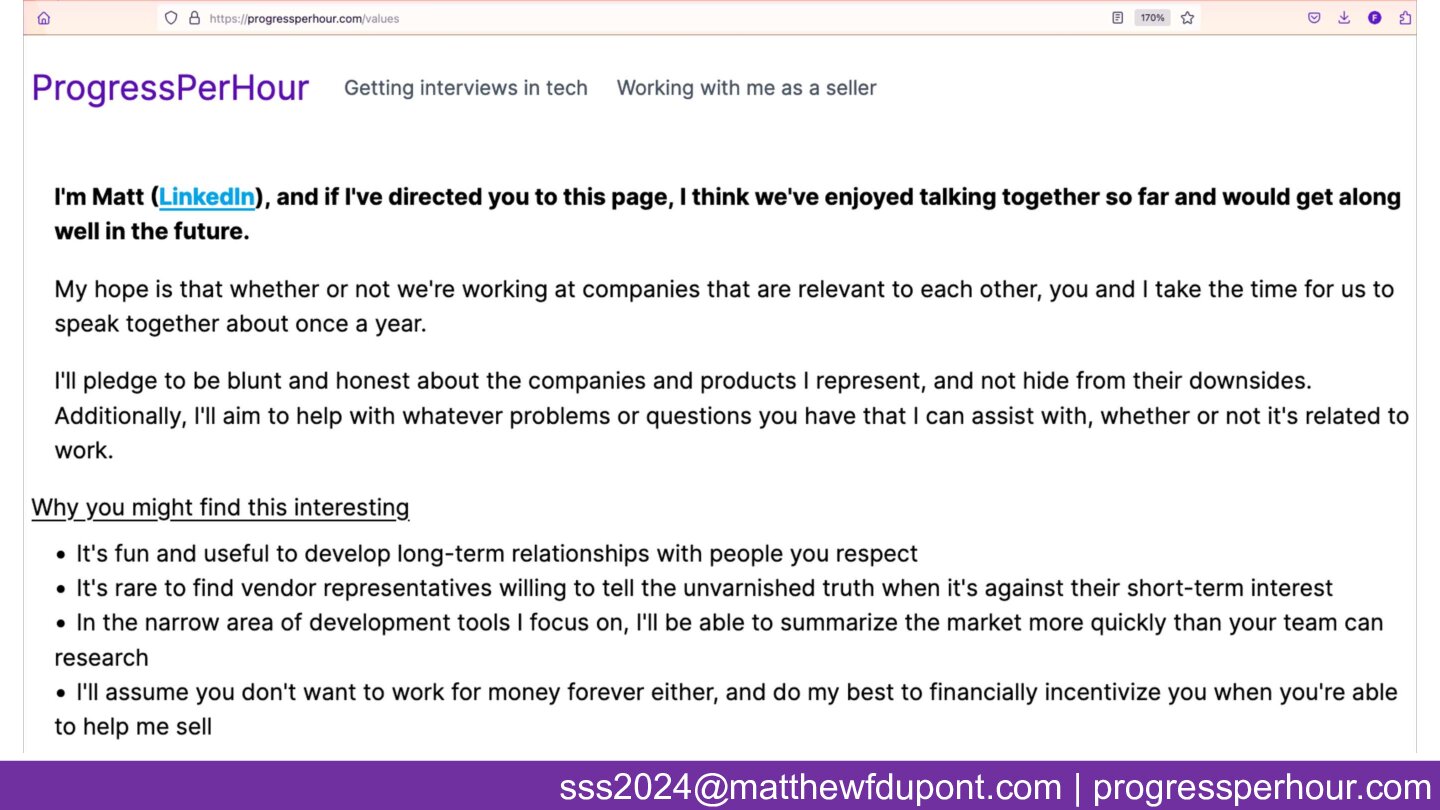
So win or lose after a deal, I send them a message saying, hey, I talked about this in the beginning, like, was I unusually honest? Like, did I actually know what I was talking about? Did I try to upsell you on something you didn't need?
And I get them to write down that I didn't do that. So six months or two years or five years from now, when that person's relevant to me again, I'm gonna send them the screenshot of them saying like, you're worth talking to. Now, I haven't been doing this long enough to have like a conversion rate or something, but this is a very congruent long bet with the bets I'm already making on my network.
And I feel like, especially for the people that aren't your champion, you don't get on the texting base and do the big deal together. You dequeued them, you send them to a competitor, you talk to them once or twice. It's a way of expanding the power of your weak ties in your network, even if you only had one or two connections.
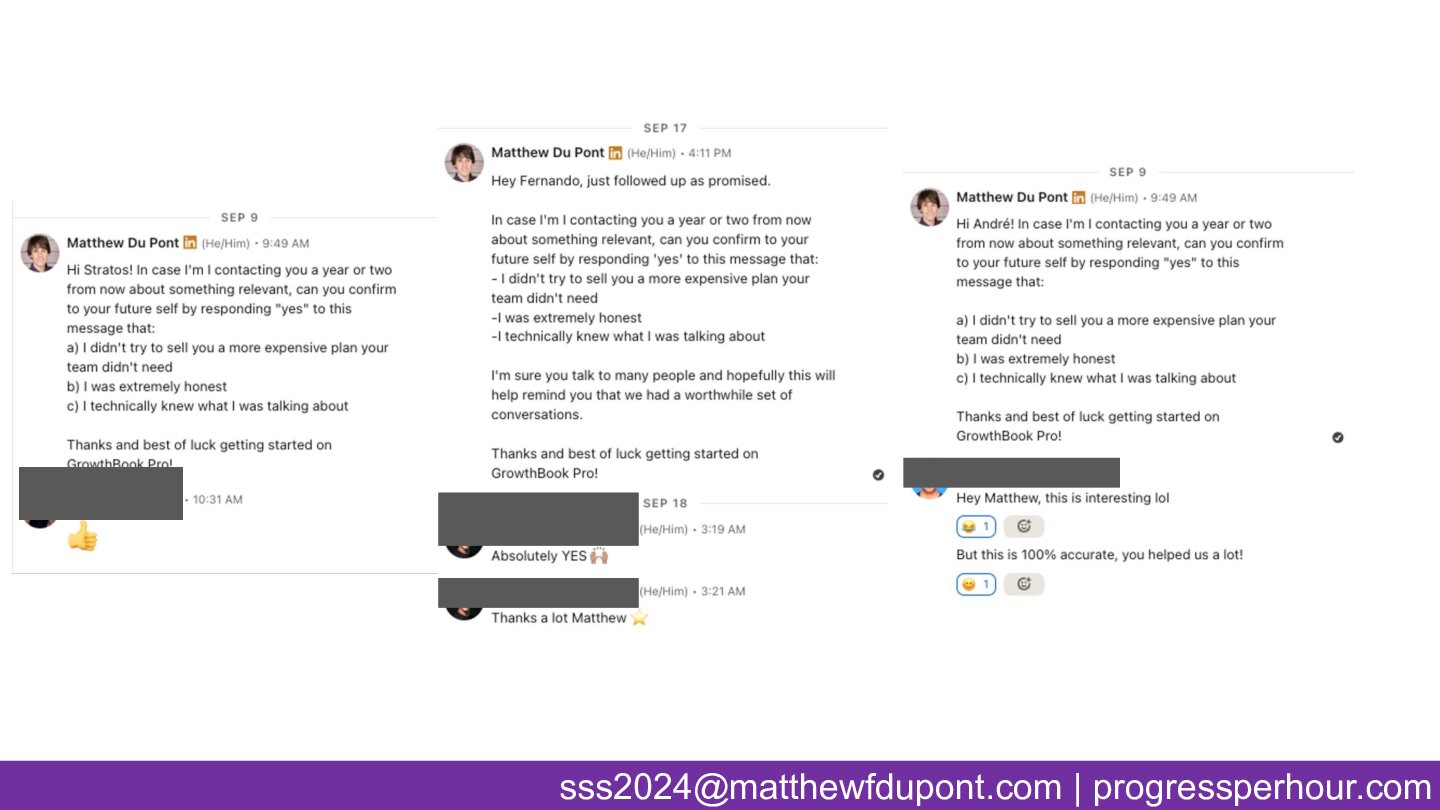
So the last thing on relationships, whoever the better salesperson is in a deal will benefit the most from knowing all of the companies in the deal. So if you think you're the best salesperson, you should be adding everyone that works with competitors on LinkedIn. Like half the salespeople will just blind accept these connection requests.
And I have 30 competitors in my space. And so it's very valuable to see which BDRs and AEs are connected to the folks that I'm talking to, because I pitch differently based on who I think I'm up against, even if I'm not sure yet. This takes no time to do.
If you're selling in Intel, good luck. You have to add half the population to the United States. But if you're selling in startups in any way or even mid-tier companies, just add all their AEs, half of them will say yes, and you might get some competitive Intel.

So, that's most of what we're covering today. I hope at least a few of these things are like interesting new ways to think about your daily practice. It's a quote I like that I really thought was a Chinese proverb, and no one knows where it's from, but it's definitely not a Chinese proverb.
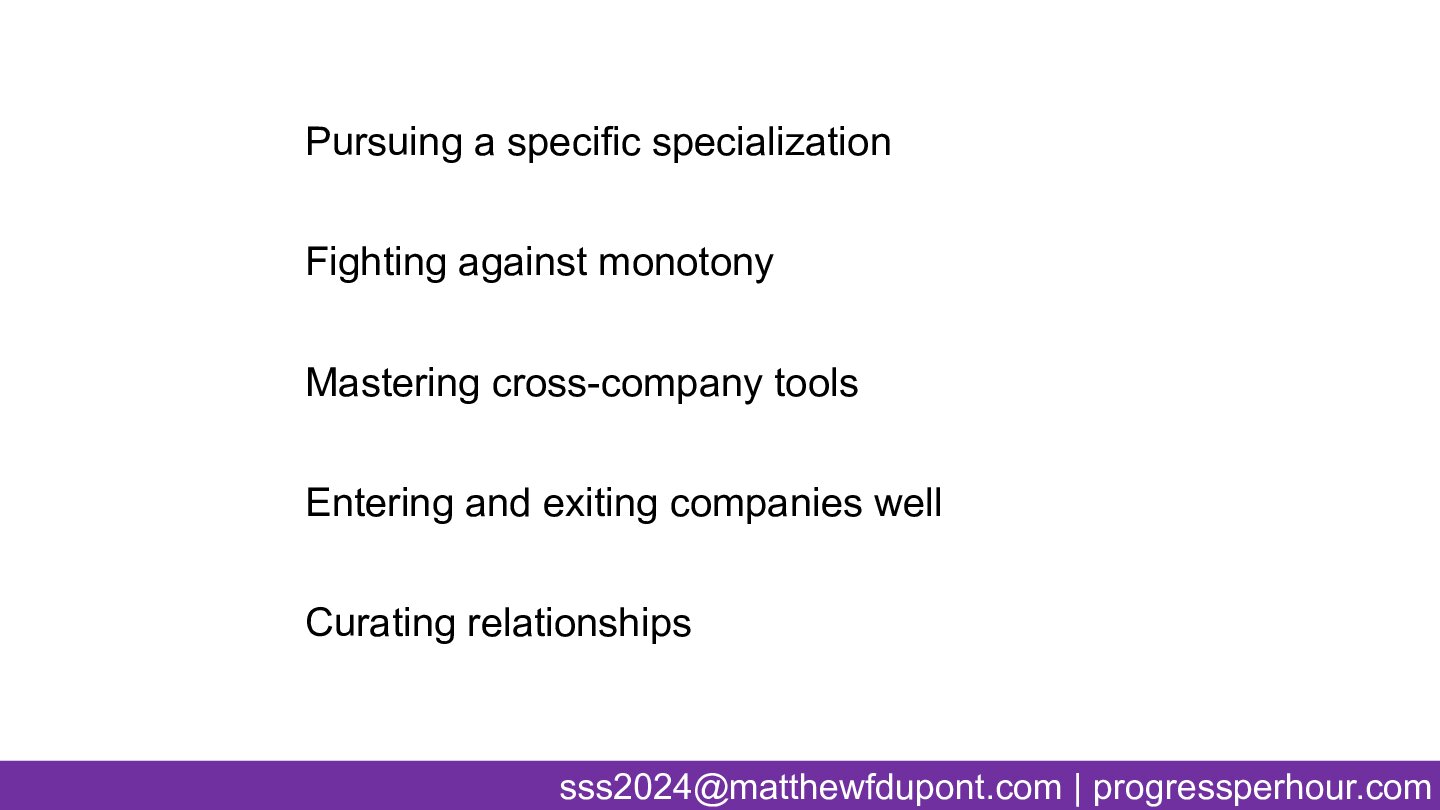
The best time to plant a tree was 20 years ago, the second best time is now. So, a lot of this stuff is work. It's just like, you know, it's not going to be as immediately useful as the things you're going to learn at this conference.
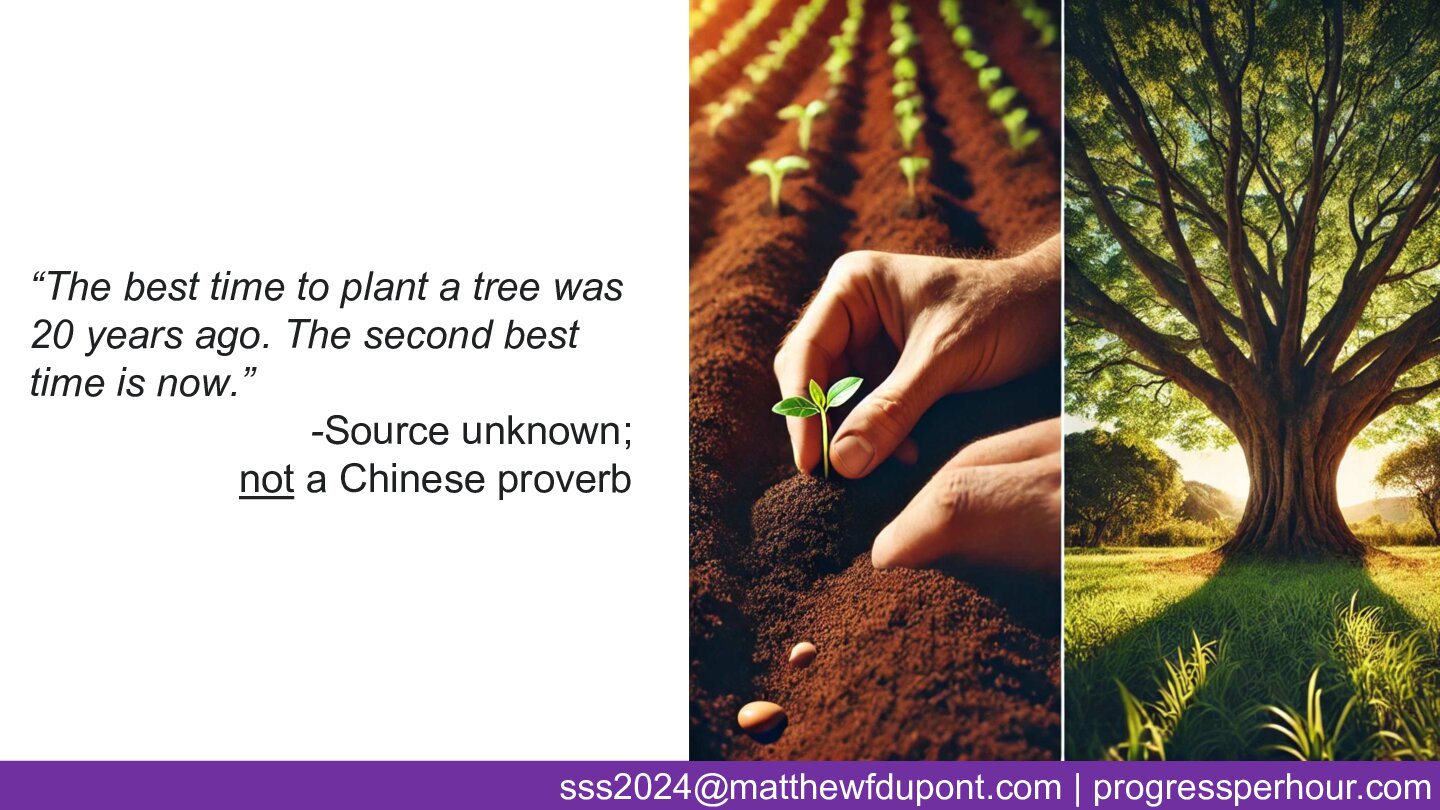
For the same reasons you probably don't want to do it, that's what stops the most people from doing it. And if you are disciplined enough to follow the same strategy for five or ten years, and I'm relatively early in that journey, I'm definitely starting to see the gains. Like, I'm going to be the laziest and most successful salesperson in five years.
I hope you can join me. So, any sales talk needs to be completed by a pitch, right? So, I don't have a course, I don't want your money, you're not my buyer, but I do love referrals.
And if anything about this talk is trickier than this oddly methodical gentleman, is probably going to follow up on what I sent him and probably do a decent job of it. Let me know if you want to be in the set of people that I look at your LinkedIn, see if I need to connect to anyone and you know, I do make a habit of working at companies that, you know, pay a decent percentage of any deals to external folks that recommend us. You already have a company.
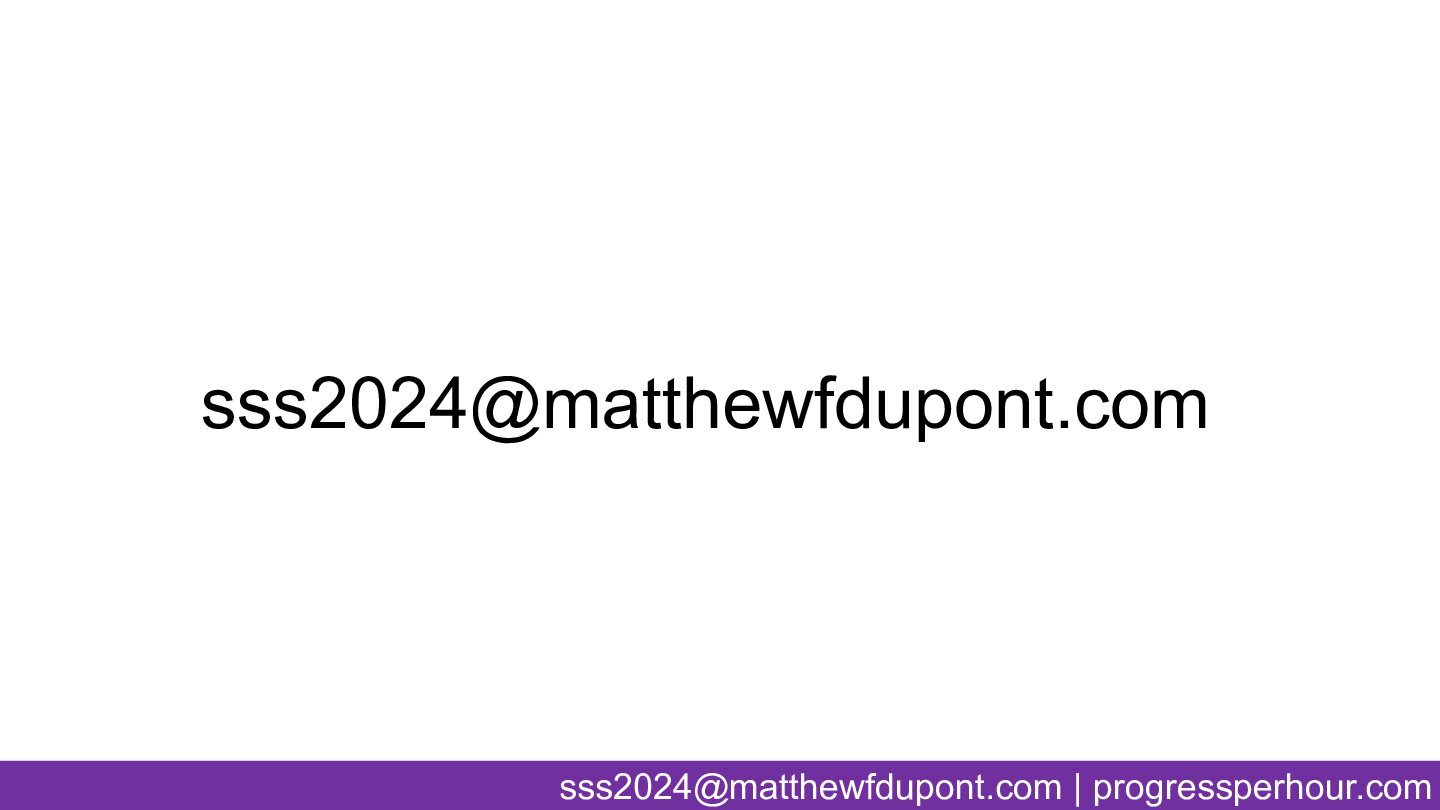
So, whether you're watching this in the future or sitting in this room, hit me up and I'd love to work with you in the future. Thank you all so much. I am deeply invested in the success of this strange and wonderful group of people and I look forward to learning from you for the next few days.